#but i do like character etymologies
Explore tagged Tumblr posts
Text
Underrated part of writing and creating characters; making their names have hidden etymologies. Some people just go "oh yeah I named my character this because it's cool", and that's perfectly fine, but I also love when a character has a name that also has a meaning attached to it.
Even if it's something ridiculous or very blatant, like Malum Caedo from Boltgun (literally "I cut down evil"), it's very fun to see. I've done this with a number of my characters, sometimes making kinda janky amalgams with names and words.
Please take this as an invite to tell me about any characters you have made/have appreciations for that have etymologies to their names. I would like to be able to read about some of them.
#writing#warhammer 40k#warhammer 30k#40k is rife with them#avoid the obvious like ferrus manus#cause yeah. metal hands man. is named metal hands. much thought#but i do like character etymologies#its neat to see what meaning may or may not reflect aspects of a character that are subtle til it becomes obvious
20 notes
·
View notes
Text
暗き夜の闇に於きて描かれたる我は、腐りの眞中に宿る。
此れ等の壁は又再び閉ざし行き、各々の物は死に似たり。
己作りの何某の己が憎み、己が身を捜し求むる何某の穴。
我が土は我が魂にして、我が棺は我が肉にして、我が神殿は我が體也。
神無月の旭に照らされたる我が體は、いみじく血塗れ也。
[Classical transliteration]
Kuraki yo no yami ni okite wegakaretaru ware fa, kusari no manaka ni yadoru. Kore-ra no kabe fa mata futatabi tozasi-yuki, ono-ono no mono fa si ni nitari. Ono-dukuri no nani-gasi no ono ga nikumi, ono ga mi wo sagasi-motomuru nani-gasi no ana. Wa ga tuti fa wa ga tama ni site, wa ga fitugi fa wa ga sisi ni site, wa ga kamu-dono fa wa ga karada nari. Kamu-na-duki no asa-fi ni terasaretaru wa ga karada fa, imiziku ti-mamire nari.
[Modern transliteration]
Kuraki yo no yami ni okite egakaretaru ware wa, kusari no manaka ni yadoru. Kore-ra no kabe wa mata futatabi tozashi-yuki, ono-ono no mono wa shi ni nitari. Ono-dzukuri no nani-gashi no ono ga nikumi, ono ga mi wo sagashi-motomuru nani-gashi no ana. Wa ga tsuchi wa wa ga tama ni shite, wa ga hitsugi wa wa ga shishi ni shite, wa ga kan-dono wa wa ga karada nari. Kan-na-dzuki no asa-hi ni terasaretaru wa ga karada wa, imijiku chi-mamire nari.
pictured in the blackness of the dark nights, I dwell within decay:
these walls are closing in again, & every object resembles death,
some self-created self-hatred, some hole in which I seek myself,
my soil is my soul, my casket is my flesh, my church is my body;
bloody, so bloody is my body in the morning light of november.
#🫀#.#poetry#voidic3ntity#translation to classical japanese#translator’s notes below#the recurring root word in the translation is おの ono#己/自 ono or 己れ onore is a reflexive pronoun meaning ‘one’s self’#各々 ono-ono is likely related thereto & it means ‘each & every’ (as in ‘each & every individual self counted together’)#‘church’ in modern japanese is usually 敎會 kyōkai but its literal meaning is ‘(a place of) gathering & (receiving) doctrine’#so i went with 神殿 kan-dono ‘temple; sanctuary’ (literally: ‘house/hall of god(s)’)#塗れ mamire ‘covered/stained all over with/in (some liquid or particles)’#‘november’ in modern japanese is simply 十一月 jū-ichi-gatsu; ie. ‘the 11th month’#in japanese poetry though one would rather use archaic names of the months that followed the traditional lunar calendar#there are also 12 months in total in the japanese lunar calendar but they do not map nicely to the gregorian calendar#長月 naga-tsuki (‘the long month; the month of long nights’) covers the 2nd half of october & the 1st half of november#the month that covers the 2nd half of november & the 1st half of december is called 神無月 kan-na-dzuki#BTW this one has a whole story behind it#it is a compound of 神 kami ‘god; deity’ + な na (genitive particle; a modified form of の no) + 月 tsuki ‘moon; month’#so it just literally means ‘the month of gods’#however な na came to be written with the character 無 (‘naught; none; null’) & the meaning shifted to ‘the month of NO gods’#therefrom arose the folk etymology wherein all of the gods were said to gather at the Grand Shrine of Izumo during this month#(leaving no gods in the rest of the land)#in the Izumo Province itself this month would be sometimes called 神有月/神在月 kami-ari-dzuki ‘the month when the gods are (here)’
36 notes
·
View notes
Note
Hii! I was wondering if you could make a post about the etymology of the name Druk (Zuko’s dragon)? I googled it but the result was kinda confusing 😭
What's in a Name: Druk

According to the Korra artbook, Druk is the offspring of Ran and Shaw, the dragons that taught Zuko and Aang the Dancing Dragon forms. Meaning the golden egg that Aang and Zuko found was probably baby Druk.
I bring this up because Zuko's dragon is actually named after the thunder dragons of Tibetan and Bhutanese mythology. Druk is also the Tibetan/Bhutanese word for thunder; this is due to thunder being attributed to a dragon's roar in Tibetan/Bhutanese folklore. In fact, a more literal translation of the word druk would be "cloud voice". Considering the cultural inspiration for the Air Nomads, it's likely that Aang had a hand in naming Druk.
In general, Druk's name creates a lot of interesting cultural and thematic connections:
Zuko's Blue Spirit mask is a "Dragon King" mask. The Dragon King is a rain dragon who can conjure up storms. Since Zuko's alter ego embodies a dragon of rain, it's fitting that he would name his animal companion after a dragon of thunder. Zuko clearly likes weather dragons.
Until Korra's time, lightning bending was a skill reserved only for the Fire Nation's royal family. Since there can't be thunder without lightning, Druk's name also alludes to his connection to Fire Nation royalty. It's even possible that Druk is also capable of lightning bending; after all, dragons are the original firebenders.
While Chinese culture attributes dragons to the cardinal direction of east, Tibetan culture attributes dragons to the cardinal direction of west. Druk's name is a subtle nod to Iroh's "Dragon of the West" legacy.
The name Druk is also significant in Vajrayana (Tibetan) Buddhism. Drukpa or "Thunder Dragon Lineage", is a school of thought in Vajrayana Buddhism. Also, the name Vajrayana literally means "The Thunderbolt Way" in Sanskrit, in which lightning is used as a metaphor for the "jolting" nature of enlightenment. Considering that Druk is the offspring of Ran and Shaw, who "enlightened" Aang and Zuko on the true nature of firebending, his name is quite fitting.
All in all, Druk is probably one of the best named characters in the entire ATLA franchise.
Like what I’m doing? Tips always appreciated, never expected. ^_^
https://ko-fi.com/atlaculture
284 notes
·
View notes
Note
I see you mention Magical Archives a lot. Is that like an official artbook? Can I get it in English somewhere?
Hello hello! Thank you so much for this question, I have been hoping to write about this for weeks 🥳

The Magical Archives Game Guide vol. 1 (full name: 『ディズニー ツイステッドワンダーランド』公式ガイド+設定資料集 Magical Archives ) is maybe the single-most informative Twisted Wonderland resource available!
It includes a huge amount of extremely detailed information, from gameplay to the characters to early-stage development illustrations to a multi-page interview with Toboso Yana herself, only one of two that she has ever given on Twisted Wonderland.
While it may be described as an artbook it is also much, much more, and if you are only capable of purchasing one piece of Twst merchandise in your life, it is absolutely the #1 thing I would recommend.
First published in 2020 it is still available for purchase from outlets such as Square Enix's Online Store, Amazon, Rakuten, Animate and more.
It is not currently available in English, but for a brief while Aniplex USA was releasing "Player Guides" for free via social media:
These were multi-page PDFs that were, visually, quite similar to the first 1/3rd of the Magical Archives game guide, but with updated gameplay information.
These game-guide-inspired PDFs combined with how out of date the gameplay information in the original guide has since become makes me wonder if maybe there not are any plans for any official translation of the original Magical Archives :<
There has since been a second volume of the Magical Archives released (in September 2024), but it is not quite as detailed as its predecessor, including gameplay information and a huge library of game sprites but very few sketches from Yana and no interviews.
On the subject of translated art books, there actually is an official English-language book being released in December!

While its English-language title is "The Official Artbook," this is actually one of four books of a series called "Visual Books!"

Much like the magical archives the first volume is the most detailed, including pre-colored base art and the occasional messages from Yana to the colorist (re: a comment that there is no need to put any light in Rook's eyes for his labwear vignette groovy ww).
The Visual Book Series is not really comparable to the Magical Archives, consisting of pre- and post-groovy card art.

The "Design Note" might be the closest to the usual definition of "artbook," consisting of insight into event outfits worn by various characters and even including a few sketches of unused designs.
Unlike the Magical Archives, however, there are no behind-the-scenes notes such as "He has a black-hearted side, so he may laugh with a hint of that often" (about Trey) and "He has vertically-slit pupils that become round in dark places" (about Leona), which can only be found in the game guide.

There are also volumes 1 and 2 of the Art Gallery! These are collections of artwork by artists that are unaffiliated with Twisted Wonderland, depicting Twst's characters, much like Square-Enix-branded fan art (no contribution from Yana involved).
Lastly, there are the fanbooks! Contrary to their titles they do not consist of any fan-made content.

Volume 1 of the Fanbook mostly consists of character/story overview, but it also has some fascinating etymology information and exclusive interviews with several members of the voice cast!
The second fanbook focuses moreso on events, and also includes detailed recipes of Master Chef cuisine, a report on the since-concluded Twisted Wonderland Exhibition, a look into a Twst-themed hotel room in Tokyo Disneyland's Ambassador Hotel, and more.
And a third fanbook was just recently listed 🥳 (Amazon link), said to include event, card and story content from the 2nd to the 4th anniversaries.
I hope this helps! ^^
167 notes
·
View notes
Text

Monsters Reimagined: Kobolds
I started playing d&d during 3rd edition, which presented kobolds as a trap happy gaggle of dragon obsessives who were counted as the weakest but smartest of the traditional dungeonfodder humanoids. Other than being lizardy they were presented near identically to goblins, both being petty and cruel and resentful over their small stature and the place it meant they occupied in the world. This overlap is actually one of the reasons I haven't gotten to kobolds before now, as I kinda felt like I covered most of it in my writeup for goblins a couple years ago.
Since Kobolds are a reoccuring request however I eventually decided I was going to give the people what they wanted. My plan was to talk about d&d dragonsimp kobolds vs. warcraft candleloving kobolds vs. jrpg dogpeople kobolds, and how all of these relate back to creature's mythological origin but hey wait a minute the official forgotten realms wiki says WHAT ?

Huh, that sounds like a weird sort of projection from a man who's super insecure about his height. I wonder if the original dragon magazine listed as a source here has anything more to.. Oh.... OH-NO

Living space, huh? Extinction of weaker peoples, eh? A religion based around survival, insularity, obedience, and the defeat of stronger enemies through attrition, yadon'tsay? Man, the canine kobolds might be on to something because there's an ORCHESTRA of dogwhistles going on here.
Friends, there's a lot to unpack here, so like a kobold with a pickax lets dig in
Where it started: the connection between kobolds and goblins and gnomes predates d&d back to mythological roots, as all are names shared by the european folklore character of "weird little guy who lives under the hill and plays tricks on us". Kobolds have an even more delightful bit of etymology attached, as miners blamed them for magically transforming valuable silver for (at the time) worthless cobalt. Originally my rehash of kobalds was going to centre on them as tinkerers/engineers for this reason, as alchemical cobalt batteries sound rad as hell.
Kobolds are in this way also part of the greater traditions of "mine spirits", Knackers, tommyknockers, and the like. Who play tricks on miners, and are just as likely to cause disaster when displeased as they are to warn of it when befriended.
Then the d&d authors did what they always do, they pilfered the name of folkloric creatures for the game while ignoring actual mythology, drawing hard and fast lines and making up rigid catagories as they went.
What's wrong: Given their proclivity for traps, sneak attacks, and guerilla tactics you end up getting a LOT of comparisons between Kobolds and the Viet Cong… which I find very telling. So many of the original d&d antagonists were vessels for middle aged geeks of the 70s and 80s to hit back at their insecurities ( whether it be challenges to their masculinity, sexuality, or something more existential) it doesn’t surprise me at all that d&d has an enemy that let american boomers rehash their nation’s at the time biggest military debacle.
Kobolds are so weak and undeserving you understand, they’ve only survived because they’re tricky, but this time we’ll get them, if we come in with enough firepower and hirelings to get through the meatgrinder we can finally hit them where they live and deal with them for good.
D&D worldbuilding imagines kobolds as “the other” from an occupier’s lens: resentful of their rightful displacement, nursing their hatreds in the shadows, emerging only to attack or to steal and despoil what they’ve been denied. They have no ambition, no culture, no wants beyond being a threat for the new dominant power. They’re cowards for using traps and poison and tactics on those here to plunder their homes.
What’s worth Salvaging: While the 3e revision of kobolds as dracomaniacs is a welcome change from their old lore I’m not especially fond of it. Overuse of dragons is one of the things that most turns me off general fantasy media. Any group of sapient creatures serving a dragon is just as likely to form a dragoncult, it doesn’t make kobolds special.
That said, if you did want to double down on kobold dragon worship you might consider spicing in a few elements from my revamped version of Tiamat, painting their reverence not just as ego and overcompensation but as a desire to emulate and become…certian kobold enclaves possibly using sorcery or alchemy to transform a chosen among their people into a fully fledged wyrm.
While we’ve mostly tossed alignment to the curb where it belongs,to distinguish kobolds from goblins it might be worth leaning into their lawful aspects; Underfoot foremen and notaries and work crews addressing things with a utilitarian collective effort before scurrying out of sight when the shift change occurs. Where as goblins are screwball and slapstick onto the verge of cartoonishness, perhaps kobolds are practical and industrious to the point of causing problems: They dam a river to access a sacred cave heedless of the disruption and flooding it’d cause, they tear down, occupying and restoring a derelict mill and restoring it to function regardless of who owns it, undermining the foundations of the duke’s palace following a vein of copper in the nearby hills.
This efficiency-focused attitude also helps thematically define mechanically minded kobolds against gnomes and dwarves as the game’s other tinkerers: They share the practicality of dwarven artisans and the inventiveness of gnomish artificers, but lack the sentiment the other two place on what they make. Kobold craft is often regarded as lower quality, but that’s because resource efficiency and easy replaceability are primary metrics upon which they judge something.
Artsource
377 notes
·
View notes
Text
okay okay okay, but we need to talk about the name etymologies of the four central characters of haikyuu!! because it is literally impossible to talk about it too much. first let's break down all the kanji in their family names!
(sidenote: all of the translations were pulled from wikitionary, so if any of the meanings are actually egregiously incorrect, pls lmk!!)
影 kage - shadow 山 yama - mountain 口 guchi - mouth 月 tsuki - moon 島 shima - island 日 hi - sun 向 nata - direction
adding a readmore because this got so much longer than i intended it to be
so some of these are talked more about in the fandom than others. i think it's practically common knowledge (if it isn't, well now you know) that the first kanji of hinata's name (日) means "sun" and the first kanji of tsukki's name (月) means "moon," and that this was done on purpose to highlight their roles in the story as foils and as a sun and moon analogy. tsukki and hinata are quite literally polar opposites in their approach to volleyball (they are, one might say, like night and day). tsukishima with his physical advantage yet reluctance to try too hard compared with hinata's overwhelming physical disadvantage and his willingness to go above and beyond, to the point that he can't even fathom how not to give 110% at all times. (there's so much more to say about this symbolism but i'll leave it there, gotta stay focused rip).
the first kanji in kageyama's name (影) meaning "shadow" i feel like most people are aware of as well, this symbolises his general mood (sorta a comparison with tsukishima too imo, darkness and the moon etc., but that's quite subtle), and again this furthers his parallel with hinata, juxtaposing light and darkness, but the kanji for yama (山) which we find in both kageyama and yamaguchi's name, means mountain, which represents both reliability and strength. this works for both kageyama and yamaguchi in different ways. from day one at karasuno, all of the team members can count on kageyama to perform, be it setting, serving, receiving, he is all around the uncontested best player on the team, and serves as the base for nearly all of their strategies. yamaguchi doesn't have the same dependability in terms of athletic performance (at the start of the series), but in a lot of ways he is a grounding force in among the first years, and in his relationship with tsukki he is very much a needed support, tsukishima depends on yamaguchi for... god for so much actually.
and then there's the second kanji in tsukishima's name (島)... meaning "island," it is very clearly meant to represent the isolation tsukki both feels and imposes on himself at the start of the series. i also think it's of note that an island is opposed to a mountain - both are large(-ish) landmasses but the mountain is connected to the rest of the land while an island is all alone...
the individual kanji all have a lot of symbolism going on but when you put some of them together, i think you get a new significance...
日向 hinata - the direction sun in shining 影山 kageyama - the dark side of the mountain 山口 yamaguchi - the mountain’s opening (or mouth maybe cave?) 月島 tsukishima - moon island
to get them out of the way, the compound meanings of tsukishima and yamaguchi don't seem very narratively significant, but i am more than open to analyses you might have that i didn't think of! :)
however hinata and kageyama seem poetic to me in a way that i don't think is accidental. i did take some liberties with the phrasing (kageyama could also be written as "the mountain's shadow"), but it doesn't change the overwhelming symbolism. the dark side of the mountain is obviously juxtaposed with the light side, but how do you create a shadow? well the sun has to shine on something... the direction of hinata's sun shining on the kageyama's mountain making the shadow... i admit i might be reaching with this one. but i like it.
initially, i had only planned to look into their family names, but after finding so much symbolism, i though why not look into their given names and boy oh boy am i glad that i did~
飛 tobi - flight, fast, high 雄 o - something large powerful and masculine (yang) 翔 sho - soar 陽 yo - alt. the sun, positive, (yang!!!!) 蛍 kei - derived from firefly 忠 tadashi - loyal, devoted, faithful
where do i even begin i legit have tears in my eyes okay, first things first, kei has always been my favourite name in all of haikyuu, i just like how it sounds, i think it's so pretty, and in looking up the meaning of the kanji i've grown to love it even more. as a masculine name, 蛍 is pretty rare, it's more commonly used for female names and the most common reading isn't kei it's hotaru. i like that tsukishima has a relatively unique first name, but what really gets me is the etymology. the kanji 蛍 is the same kanji for firefly, and when the kei pronunciation is used, it means fluorescent. i absolutely love this for tsukishima, because we are being given two different messages with his family name and his given name. on the one hand, his family name would have us believe that tsukki is like the moon, only able to be seen at night and only capable of reflecting the lights of others, but his given name tells us that, while it might be a soft glow, tsukki does have a light of his own, he is in fact able to shine by himself.
compared to 蛍, 忠 is a much more common given name, meaning loyal or devoted. i think sometimes people misunderstand the dynamics between tsukishima and yamaguchi, so please don't take this as me saying something i'm not, but tadashi really is loyal to kei in a very special way, and this is clearly something that furudate wanted to highlight, as this is not the only time he's made reference or used symbolism for tadashi's loyalty to kei. i do think that this devotion extends past tsukki too, and tadashi's loyalty is another part of what makes him such an important part of karasuno (and eventual team captain).
now. for the big ones. i really hope people are still reading because i saved the best for last just because i know i'll collapse into a puddle of tears once i finish typing this section out
if you look at tobio and shouyou's names individually, they do fit them very well; 飛 (tobi) being the kanji for flight ties kags to the sport of volleyball, and the alt meaning of height i think references how high he is going to aim for and eventually reach, and 雄 (o) symbolising something powerful and masculine i think does fit kags' vibe. likewise, 翔 (sho) forshadows hinata's jumping abilities and his bird-like nature, and 陽 (yo), a kanji that has sooo many potential meanings, among which are sun and positivity, further underscores hinata's sun symbolism and his optimistic outlook. astute readers might have already noticed, the first kanji of tobio's name (飛) and the first kanji of shouyou's name (翔) have very similar meanings, one might even go as far to say that they are synonyms. both kags and hinata learn to fly at karasuno together, and they both aspire to the same upwards trajectory, literally in the game for hinata, and figuratively in their careers as pro volleyball players, and this similarity is underscored by the similarity in the meanings of the first kanji of their given name. but the kicker, the last kanji of their given names, 雄 (o) and 陽 (yo) not only sound similar, but they both are kanji that can be used to write yang as is yang, the opposite of yin! shouyou and tobio's names are literally synonyms of one another!! for all the differences apparent in their family names, their given names are literally the same name just a different font and i absolutely love it so much, because we spend so much time talking about how different hinata and kageyama are but part of the reason that they click and clash the way that they do is that they are so similar to one another in ways that they aren't like anyone else, it's what makes their rivalry and their partnership as strong as they are and it's so so so important to remember that these boys are always on the same wavelength!! clearly we're meant to think like this, since furudate chose these as their names...
one last little note, it might be hard to tell if (like me) you aren't used to reading caligraphy, but the same kanji in tobio's name is the kanji on karasuno's banner: 飛
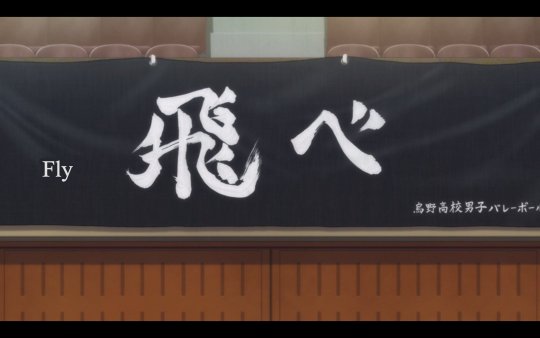
so just in case there was any doubt as to where tobio belongs. his name is literally on karasuno's banner i can't i can't i can't
#thank you for coming to my ted talk#crying uncontrollably at all the symbolism i love this series so fucking much#haikyuu#hinata shouyou#kageyama tobio#tsukishima kei#yamaguchi tadashi#kagehina#tsukkiyama
337 notes
·
View notes
Text
This all started because looking up today's Semantle answer's etymology got me to "assess" deriving from Latin meaning "to sit beside" [as a judge's assistant, who was responsible for setting the value of fines and taxes, among other duties, would do]. Which send me down a rabbit hole of "Wait?! Is that where we get "ass" from?!"
And no. No it is not.
But you can see how I might make that connection of "seat" to "butt". "Ass" is actually much older - The "donkey" sense came to English specifically via the Germanic side of its DNA, but the word itself is ancient-ancient. Well-conserved throughout many branches of Proto-Indo-European, but curiously not likely of PIE origin - It likely came from a language in Asia Minor - To wit, Sumerian has a cognate.
The anatomy-slang sense of course, derives from "arse" - Just a variant pronunciation first noted in 1860 that caught on largely in America and was popularized in general usage by the 1930s.
Arse also comes to English via the Germanic side of things (meaning "rump/tail" originally - So that's pretty well-conserved). It's a PIE word originally, with cognates in a few far-flung branches like Greek, Hittite, Armenian, and Old Irish.
Even before the official pronunciation shift and split into a distinct word though, "arse" was dissuading people from using the word "ass" for donkey in "polite company".
In the middle of doing my daily Semantle etymology write-up and something dawned on me:
"Consector" and "Adsecla" sound very Latin in their construction and not just funny mashed-up syllables. "Caenum" means "mud/filth", so it tracks that we've got more Latin-ish words. ("Boccular" means "mouthpiece" apparently, which... sure?)
Plugging "consector" into translate churns out "reaper" which tracks, honestly.
"sector" itself seems to be a pretty good fit with "pursuer". "Con-" is a prefix that means "with".
"Adsecla" is less easy to crack.
"Ad-" has a lot of versatility as a prefix, but indicates an association ("to", "on", "towards", "near", "after", etc.)
"Secla" translates as "Century" which doesn't seem quite right here in this context. Hmm...
"Teletheric" has Greek roots, as our modern Tele-words do, in this sense would mean probably roughly "across the distant sky".
"Secla" [or it's proper-character equivalent, "σέκλα"] in Greek comes back as "chair" in English. This might be the right trail.
"Sella" is chair in Latin, with some related terms introducing that "c" - "lectica" is "sedan chair/litter"
Okay, so "to the sedan chair" - ~"Official assistant while travelling on official duties"?
(comes back as "ad sella" or "ad lectica" when plugged into translate)
I don't know if that's the exact logic, but I think it tracks pretty well.
Obligatory:

#midst#midst podcast#etymology#further thoughts#separated from main thrust of post#also probably spoilers for today's Semantle if you haven't done it#semantle spoilers#watch there be like somewhere that they actually have already detailed out the whole derivation of the words in Midst somewhere#and all this was a waste of time :p#(also: I name [mostly] all of my myriad Aasimar characters using Latin-via-Google-Translate so I get it. I totally do]#(In-story for my world the Aasimar have [mostly] been flung to the future from an Ancient lost vaguely-Roman-esque Empire)#(It's a plot point that none have been born since those times. And that the first* new one had been born just recently#*as far as my lore goes for now - I might come up with some other reason for other ones or something#She's now 23 so that she can reasonably be a PC)#(She's an Artificer by trade and she was born a Tiefling - So even less expected to develop Aasimar traits - Which came in as she grew up)
12 notes
·
View notes
Text
Jupiter & Rahu : Ditziness & Weird Girl Humor
This post is inspired by an ask I received a while ago
Jupiter & Rahu girls in comedy cinema/television often play airheaded characters who are a bit ditzy and zany. Another feature is that all these characters are mostly harmless, good natured people. They can be mean/blunt but its because of their ditzy, airheaded nature and not out of malice.
All 3 Jupiter naks belong mostly to air signs (Punarvasu- Gemini, Vishaka-Libra, Purvabhadrapada- Aquarius) and same goes for all 3 Rahu naks (Ardra-Gemini, Swati-Libra, Shatabhisha-Aquarius) in fact all Rahu naks come right before a Jupiter nak. I have always personally believed that Rahu & Jupiter are similar in many ways but obviously different as well. Rahu is limitless expansion. Jupiter is boundless expansion within principles.
But all that aside, Jupiter & Rahu are literally air influenced and I do think its the presence of an excess of Air that makes someone come across as "airheaded".
The etymology of the word "airhead" is that one's head is filled with air and is thus empty. I have talked about Jupiter & even Rahu's limitless nature feeling "empty" for the natives themselves. Out of all the elements, air is the only one that can really said to be boundless, its not measurable or calculable, its just there, unlike water or earth or fire. but air has no physical form and while that is liberating, it also makes one feel empty and untethered and these are all emotional issues that a lot of Jupiter/Rahu people deal with.
But anyyywayys,
youtube
Cat Valentine on Victorious played by Ariana Grande is a really good example of an airheaded, zany comic character.
Ari has Ardra Sun & Mercury in Punarvasu (Rahu + Jupiter influence)
I will include Mercury placements because Mercury is literally how we communicate with others??
youtube
Phoebe Buffay from Friends is another good example of this type of comedy. She is played by Lisa Kudrow's who has Rahu conjunct Ascendant in Punarvasu
youtube
Kelly Kapoor from The Office is the ditzy zany delusional gal played by Mindy Kaling who is Ardra Sun & Moon, with Mercury in Punarvasu
youtube
Jackie Burkhart on The 70s Show played by Mila Kunis, Swati Moon is a meaner version of this archetype
youtube
Meryl Streep- Ardra Sun often speaks and talks this way. Just watch any of her interviews and you can sense that Rahu/Jupiter airy nature/demeanour/comic sense
youtube
Janhvi Kapoor, Purvabhadrapada Sun, Mercury in Shatabhisha is known for her "dumb girl persona" that most people think is fake but tbh I just think she's a little slow due to all that Air influence lol
youtube
Gracie Allen, Mercury in Punarvasu conjunct Jupiter is an early example of this type of humour and comedy
youtube
Cheryl Tunt on Archer voiced by Judy Greer, Mercury in Punarvasu (Saturn in Punarvasu atmakaraka)
youtube
Chrissy Snow from Three's Company played by Suzane Somers, Punarvasu Moon & Mercury in Vishaka is a classic example of a ditz
There are notable male ditzy characters as well
youtube
Andy from Parks & Rec played by Chris Pratt, Mercury in Punarvasu & Swati Rising
(there's a 10 video limit per post so I cant attach more vids)

Joey Tribbiani, played by Matt LeBlanc, Purvabhadrapada Moon, Mercury in Ardra & Punarvasu Rising is a great example of a male ditz

Harpo Marx- Punarvasu Moon, Mercury in Vishaka he was a silent comedian known for his highly exaggerated physical comedy that was very pantomime/clown-like. This is another aspect of the airhead/ditz, they don't just say dumb things, they do dumb things. Physical comedy is a big part of it.

London Tipton played by Brenda Song, Mercury conjunct Rahu in Purvabhadrapada
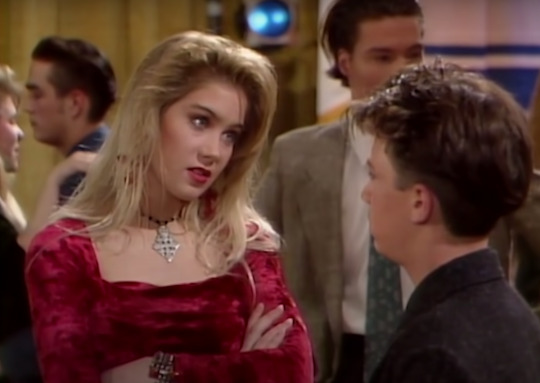
Christina Applegate, Shatabhisha Moon played a very ditzy character on Married With Children
These are all the examples off the top of my head. I feel like many Disney princesses will also fit this bill lol
lmk if you have other examples
hope this was interesting xx
#Youtube#rahu#jupiter#swati#purvabhadrapada#punarvasu#shatabhisha#vishaka#ardra#jyotish#vedic astrology#nakshatras#astrology community#vedic astro notes#astroblr#astro notes#astro beauty#astrology notes
244 notes
·
View notes
Text
let's talk about names in The Folk of The Air
I realised today that I physically CAN'T shut up about how great of an author Holly Black is when it came to reference to folklore. I mean she basically build her carrier over her fairies knowledge. So anyway, here's some info about her character names because names are so important in the Fae world.
Let's start with Jude. The lies queen, the oath traitor, the one who
gets to turn a geis at her advantage, the mind trickster, the betrayer. According to multiple etymology work, "Jude" is a alterative form for Judah and therefore Judas, the bretrayer of Jesus. In old hebrew, Jude also mean " to praise". I mean, we are all accusating Cardan of being a simp, but maybe this little fairy-boy was just doing what the name was saying.
Speaking of our silly fae king, Cardan name was formed around the word "cairn", in old english. What is a cairn ? Nothing less that some rock pile that, in some stories, where supposed to gard the sleep of old fae king that where once trapped underground because they were too dangerous (or, dare I say, wicked ?). But it doesn't stop here, since "cardan" manage to became a surname for a stubborn person, and guess where the name "Cardan" first appeared ? Cheshire (wanna guess who he relate the most to when he read Alice in Wonderland ?)
Nicasia turn. One of the oldest and most powerful ocean spirit in the celtic folklore is called Old Nick, and I think there is some reference here made by Holly Black.
Taryn. Oh dear, do I have a lot to say about Taryn name. On the matter, she is probably the most gifted. Taryn name came from a variant of Thualta, the name of the godlike people that once rulled of Ireland before leaving to the undying island. Taryn represent the embodiment of the travel from mortal land to Elfame itself. But she also wear the same name as Tara, an old Irish fairy queen, wich name blend the meaning of "hills" and "star", showing the great extent of her power. Taryn is also a name given to the river that tend to overflow often. So, just like for her name, there is much more in Taryn that what we see at first.
Vivi complete name is Vivian and I think it speak for itself. Vivian is one of the many names of the Lady of the Lake, gardian of Excalibur. Her name in particular make me feel a little bittersweat. It bear the love of her step-dad for weapon, but also, it's maybe the first name her parent assimilated to fairies, and they may have chosen it quickly since they were still recovering with all the fae-related trauma. On the other hand, Vivian is also know to have managed to trap Merlin into a rock, so they were maybe wishing for her to be capable of overpowering any fae that could have wanted bother her.
Oak means oak (breathtaking I know), and oak trees are often associated with royalty in Celtic traditions. In France, it's said the king saint Louis was use to take court under a oak trees, and oak seed are often use to keep Fae treasures safe in fairytales
Hazel share some trees linked symbolism. It's known to be a symbols of righteousness and loyalty ( quite fitting for a knight if you want my opinion)
Jack sometimes means " to take the place", and, I mean, he is a changeling after all, but jack is also a name often give' to scarecrow, a parody of human beings
Benjamin's name means "second born" . Wtf, are you thinking if you have read the Darkest Part of the Forest. Isn't Benjamin the oldest sibling? Well yes, but he is the one the fairies like the most. The one who get the gift, the one who gets the story, the one deserving of a fairytale. And in all fairytales, it's the youngest son who is the hero, and who live the story. It's the benjamin brother who gets the magical gifts from the fairy lover who's head over heels for him. Ben might be the first born but by fairytale's logic, he is a Benjamin.
I haven't read the Oak saga yet so you'll have to tell me if it fits, but Suren's seem to means "the heroic one, the strong one"in Armenian, while her second name Wren, is the one of a small bird symbolising determination, enthusiasm and happiness
Some bonus for the Spiderwick Chronicles saga, because YES, I still believe they are part of this universe even if I know they legally can't.
Mallory etymology is from the french "malheureuse", wich means "unhappy", "unlucky", but something about the name of the others characters make me think it was choosen as a reference to Thomas Mallory, academically known as the first person to mention king Arthur in a written document (actually is more complicated but the meaning is still here)
Helen can be a reference as Helen of Troy, a female character who is often perceived as irritating and uninteresting until you start to rethink the story from her point of you, just like Jared have to learn that his mom is not trying to work against him, she is just a single mom trying her best.
I believe there must be some cultural references with Simon names, but I did not find it. All I've got is that his name means"to hear and to listen" such is kinda fitting,not gonna lie, my boy is trying to hold this family together by will alone so he have to play mediator all the time. (And of course It was saint Peter first name, like @amr102 say, everybody in this family is a reference)
I think Arthur Spiderwick name is a obvious reference to king Arthur since they bear (ehee, bear,king Arthur, you have it ?) the same narrative purpose of being the focus point of action without doing anything. (Update, @amr102 also reminded me that Tony Diterlizzi, the other author of the chronicles was massively influenced by Arthur Rackam style for his illustration, so, yeah, there is a reference for both of the authors)
For Lucinda, her name etymology come from lux, the light. But in a lot of gaelic tales, such as Cuchlein and Olwein, characters associated with light tends to turn crazy and / or see what the rest of the world cannot
And finally, Jared, my favourite one yet since the theory that he was named after Jareth the Goblin King from Labyrinth 1986 will never leave my brain.
#holly black#tfota#the darkest part of the forest#cardan greenbriar#jude duarte#the folk of the air#the cruel prince#the spiderwick chronicles#taryn duarte#ben evans#hazel evans#jack gordon#jared grace
58 notes
·
View notes
Note
This might be a weird question but I can't think of a better person to ask! My nibling recently came out as non-binary and wants to change their name, but they're struggling to find something they are happy with.
They were given a feminine name at birth and are currently using a masculine name, but aren't happy with either of them. Every human name that's suggested to them is either too masc, too femme, or has poor associations. However, they love frogs, so I wondered if that might be a solution.
I've tried to find frog names that might work as a human name, but so far I'm not having much luck. It's not allowed to start with R or J, and apparently it's not allowed to have an X in it because nibling thinks they're "not cool enough" to carry that off (I've tried explaining that they're wrong, but 16 year olds are very sensitive).
If this isn't too weird a question, can you think of any frog or toad names that might be manageable as human names? We live in the UK for reference
So many thanks for even reading this giant info dump 💕
Wow this is only the second time I have gotten to help find a name for a human. What an honour.
Okay firstly, sounds 100% like your nibling is cool enough to use an X (despite my current negative emotions associated with the letter due to the Elongated Muskrat), and there are some *amazing* names out there with X's in, so they should at least consider them. Scinax and Ixalus for instance are great. Ixalus has a fun history: originally it was coined as a replacement name for Orchestes, which wasn't available because there was already a beetle genus called Orchestes. But then it turned out that Ixalus was *also* not available, because the world's most beautiful antelope, the bongo, was already called Ixalus. Only, the bongo had already been called Tragelaphus. So now Ixalus isn't the name used for *any* animal. Ixalus is Greek, meaning 'bounding, springing, spry'. Also there are numerous other frog genera that use the ending -ixalus, such as Heterixalus, Micrixalus, etc.
But, taking the lack of X seriously, here are some other alternatives. I will avoid names that are derived from other people's names, and focus on names that have a neutral ring to my ear, and are also euphonious (nice to say or hear) and fewer than four syllables. I am also only considering genus names, because there are too many species names to choose from:
Acris — meaning sharp, sour, bitter, pungent, sharp, keen, acute, energetic, eager, etc. Technically this is the feminine version of the adjective; the neuter version is Acre, but I do not think anyone would read 'Acris' and immediately think either gender. It is supposed to be pronounced with a long a, as in 'hard', but a lot of people pronounce it with a hard a as in 'ace'. This name is most familiar to Americans, because Acris are cricket frogs, widespread in the US.
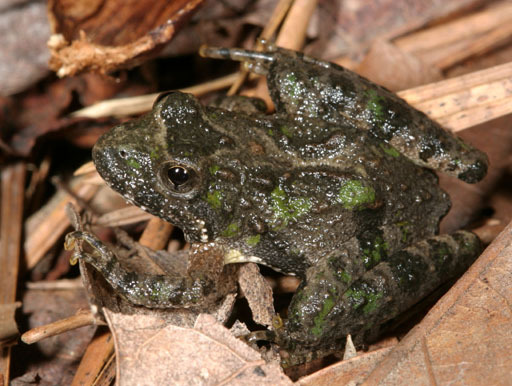
[Acris crepitans, src]
Mantis — of course, the genus Mantis was coined by Linnaeus in 1758, and so it is unambiguous that this is not a frog name. However, it is very often used as part of frog taxonomic names, such as Chiromantis, Boehmantis, Guibemantis, Gephyromantis, Phlyctimantis etc. Mantis is Greek (μάντης), and means oracle, prophet, soothsayer, seer, clairvoyant, or fortune teller. The name has the feminine gender in its language of origin, but that has no bearing on its use, which, barring the character in the Marvel movies, does not seem particularly gendered to me.
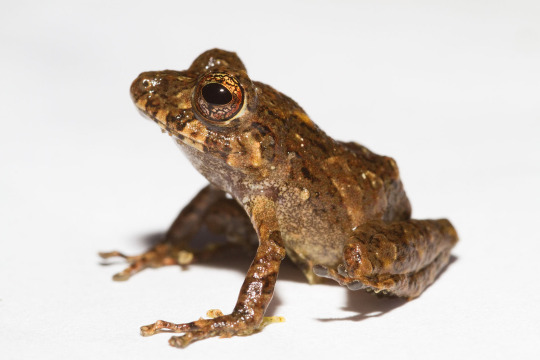
[Pristimantis cruentus, src]
Dasypops — simply a delightful name, but probably not neutral enough. I have not been able to figure out what the etymology is; it might be a play on Dasypus, the Greek word meaning 'rough-footed', which is a genus of armadillos. The frog is also spectacular, but there are no photos I can legally share on tumblr.
Kaloula — a euphonic name with an unclear meaning. Very round frogs. I love them.
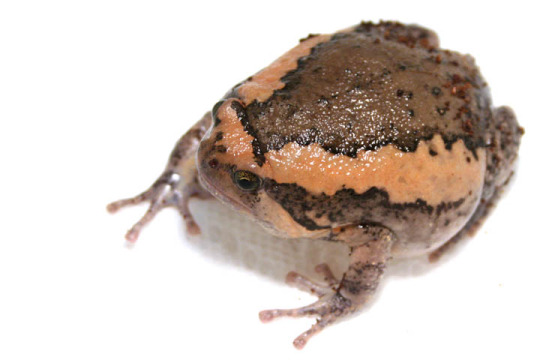
[Kaloula pulchra, src]
Adelotus — means 'unseen'. These are 'tusked frogs'. Males have crazy extensions of lower jaw bones, and they fight with them.
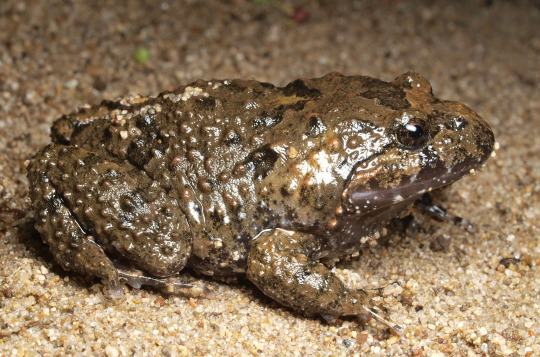
[Adelotus brevis, src]
Taruga — a Sanskrit name meaning 'tree climber'. I fucking love this name, and the frogs are just *chef's kiss* POINTY, and have really committed to bold colours.

[Taruga eques, src]
EDIT: I have been informed that taruga means ‘blockhead’ or ‘numb skull’ in Spanish, so it might not be the best choice. Sorry!
If the nibling would like to check out a list of genera themselves, there is a tolerably complete list here.
I hope this helps!
#frog#frogs#frogs and toads#names#animals#nonbinary#answers by Mark#annamelia-art#herpetology#I guess
744 notes
·
View notes
Text
Ngk.

Yes, this is meta on ngk. I know, right? Possible origins and other layers of meaning? Ngk.
When Crowley uses it, "ngk", as we know, is the sound of a very clever word nerd just being so floored, confused, overwhelmed, or otherwise incapable of speech that we might think that what he says sounds like a bunch of random letters. It comes out like a curse at times... or a !!!!!... or it would be a squeak of frustration, if only his voice weren't so deliciously low. People read it as the verbal equivalent of a short keysmash and, emotionally? It probably is, but... those letters are not at all random.
The reasons why these letters were chosen are so. very. Crowley. that I think you'll find that the character's (and Pratchett's) interesting word kink might, as Mrs. Sandwich would say, put a smile on your face. 😊
I am pretty sure that ngk is two, different but interconnected, word history jokes related to the Greek language. Why the Greek language? Because it, along with Latin, is at the core of basically every language that etymologists refer to as being part of the Indo-European language family, which is pretty much every language of European countries, the Persian Plateau (sometimes referred to as the Iranian Plateau), and the northern Indian subcontinent. If you ever do word history research on words in English or Indo-European languages, it won't take you longer than two minutes to start finding your way back to the Greek roots for many of the words you look up. Greek is both a language in its own right and also the part of the origin story of words in dozens of other languages. Greek is at the core of the etymology-inspired figurative language in Good Omens and in Terry Pratchett's Discworld novels.
Because Greek has existed as language for literal ages and is so foundational to the study of other languages, etymologists needed a way to differentiate between the before and after period of big change in the Greek language.
Known to date, there really was one, massive shift that the language underwent over a period that has been narrowed down but the exact time and cause is debated. The most common theory is that it is related to The Fall of Constantinople and the collapse of the Byzantine Empire. The point is that, during this semi-disputed period of time, Greek underwent some big shifts that are, by and large, what differentiate between what we'd call "Ancient Greek" when looking at word history and how Greek has been written and spoken since through today. It's all the same language but it's just shifted so much, especially during this one period, that there are differences in it that people looking at word history need to be aware of when looking at the origins of words versus what things might mean or how they might be spoken in Greek in our current times.
In order to do that, etymologists created the term "New Greek" to mean Greek as spoken after this period of massive change to differentiate it from the Greek of more ancient Greece. NGK or ngk is the etymology world's acronym for "New Greek." Making this even more confusing? At some point in the last couple of decades, etymologists began calling "New Greek" by a different name-- "Modern Greek"-- but it means the same thing and, from what of it I've seen, they have largely kept the same ngk acronym. (The change to "Modern Greek" happened after Good Omens was first published.)
So, the first thing of the two things that ngk is? It's Crowley being so speechless or over everything that he's like argh, it's all fucking New Greek. He's cursing or exclaiming in frustration using the acronym for the shift in languages that underpins all of the languages he most frequently speaks, the evolution of which he lived through. Even word-nerdy poets have moments of FUCK WORDS and that appears to be one level of what ngk is. This also might be a little joke as well on the controversial old idiom that exists in different forms throughout different languages-- "it's all Greek to me"-- that was popularized in Shakespeare's Julius Caesar. For more on that, I'd refer you to this really interesting Atlas Obscura article on the idiom.
Ok, so, that's the first of the two Greek-related things that ngk is. Let's look at the other one so you can see just how great a Crowley joke this...
While ngk is an acronym, it also, separately, happens to be a double consonant sound in Greek. Do not worry if it's been awhile since you studied a language, I will simplify. 😊
In English, a double consonant is when a consonant appears twice in a row in a word, like the two times in a row the letter l appears in the word balloon. In Greek, it's a different thing. A double consonant in Greek is a combination of two consonants that make one, collective sound together. Greek double consonants are closest to (if not exactly equivalent to) what is called a digraph in English phonics, which is the sound made by two letters commonly put together, like sh, qu, ch, etc. When you were first learning English, you were taught things like how sh makes a "shh" sound, in addition to learning the individual letters of the alphabet, right? That's kind of what some double consonants are like in Greek.
One of the Greek double consonants is the combination of the letters gamma + kappa in the Greek alphabet. When you say the double consonant of gamma + kappa aloud?
You are saying: "Ngk."
The letter gamma here in this double consonant is pronounced a little differently than usual and has what's known as the "gamma nasal" quality that causes it to be pronounced like "ng." Kappa here is pronounced and written like the English letter k, for which it is the direct ancestor. The pronunciation of the gamma + kappa double consonant is the sound that Crowley says in the bandstand in S1.
So, Crowley is actually cursing/exclaiming out a double consonant of the Greek alphabet...
Why? And why this one, when there are a bunch?
Start by checking out how the uppercase and lowercase letters for both gamma and kappa are written below:

Uppercase gamma is the crank part of a crank tool. Lowercase gamma is the origin of the English letter y-- homophone: the signature word of questions: why?

Gamma is a term used all over the place in math and science, including gamma rays from electromagnetism and gamma waves, observable neural movement that is connected in the mind to large-scale, high-level cognitive activity, often related to memory, perception, creativity, and attention. These are also some of the brain waves most impacted by mental health issues and that are also some of the most affected by things like meditation.
Gamma is also a Greek word for the camel. (Lest you think that Good Omens forgot a rideable animal for their never-ending horses/transportation euphemism fiesta... found the missing camel! 😂) The word gamut also comes from gamma and originally referred to music-- the entirety of the musical scale-- but now you can say "runs the gamut" about anything in a way that means the same thing as the idiom "from soup to nuts"-- just everything, from beginning to end. From creation to completion and back to the start again.
Kappa has ties to some Crowley-related science and spirituality, such as The Kappa Effect, which is a theory explaining how the mind's perception of distance can affect its perception of how much time has passed. In early Buddhist scriptures written in Pali, a kappa-- referred to as a kalpa in later writings-- refers to a very long period of time between the creation and the destruction/recreation of a world or universe and related to the lifetime of that world or universe.
So, we have memory, time, the creation of the universe, crank tools, asking questions... these letters are turning into a whole list of Crowley-related things, yeah? There's more...
Kappa is written in both cases like the letter k-- homophones: 'kay (as in, ok/okay) and cay.
The etymology of ok is actually an example of a briefly-existing cant vocabulary, which... heyyyy. That feels relevant, yeah? 😲
In the late 1830s, a (very limited) cant vocabulary emerged in New England that created new slang out of making acronyms out of intentionally misspelled existing phrases. It is thought to have started or been encouraged by a Boston Morning Post article that mocked a competing newspaper by saying it was spelling things the way its rival did-- spelling "all correct" as "oll korrect." A lot of issues of newspapers from this time period no longer exist so the exact issue that caused this paper to troll its rival is unknown. There is some speculation that it might have been something of a class warfare battle being played out between papers who appealed to different groups of people, given that the mocking "oll korrect" sounds, when spoken aloud, to be of the same pronunciation quirks of the 'pahk the kah in hahvahd yahd' variety of Boston accent.
"Ok" is believed to have originated as an abbreviation of "oll korrect." This article either prompted-- or was an example of-- a cant vocabulary that did a rare thing-- united Boston and New York lol-- for a little while in the late 1830s. There were other abbreviations used as words like this, for which you had to understand one of Crowley's favorite word things-- homophony-- and know the pattern to understand. KG meant "no go", off of the homophonic "know go," for example.
Ngk, like ok and these other words, is an abbreviation being used as a a word. Not of one that's misspelled but one that is from the cant vocab of etymology nerds, making it fun in an especially meta sort of way.
The most famous of these phrases from this late 1830s Boston/New York cant-- and the only one to survive-- is "ok", which etymologists think was probably was helped to remain by being picked up and used in President Martin Van Buren's failed reelection bid in 1840.
As you can probably tell from the fact that I said that it was used in a Presidential campaign, the cant vocabulary spilled into the mainstream and, so, lost relevancy as it was no longer something that not everyone understood. "Ok" was kind of like the "brat" of the 1840 U.S. presidential campaign, in some ways? Once everyone got the joke, people still used it in the mainstream because it was a quick thing to say or write as an affirmative but its subversion was lost by its meaning becoming commonly understood.
While this 1830s cant vocab was *much* smaller, the best anyone can tell-- more like a handful of phrases and not much more-- it's kind of similar to Polari, in terms of the language burning out but leaving lingering words in mainstream English.
Ok, so the other word from kappa: cay.
A cay is a low island. It has a synonym-- one definition of the word key (Key Largo, The Florida Keys, etc.). So, we have a low island-- the use of the beach/the sea/fish/bodies of water as figurative language for sex in Good Omens-- and its also the word that is a key. Keys you use to start engines to drive and also to unlock language. A key is the necessary component to interpreting hidden language and here's one of the keys/clues to taking apart the use of language in Good Omens right here in ngk.
Kappa is from the Phonenician kaph, which meant the hollow of the hand (the palm) when it is forming a cup shape... as in when praying/meditating or when creating or presenting something...

...and the sole (homophone: soul) of the foot-- its arch, in particular. Arch, alternative meaning: playful, knowing, dry teasing.

In other words, kappa, etymologically, is the movement of the hands and feet-- it's living on Earth. It's using the hands to make magic and art, to worship and give to others. It's the the cobbler walking the Earth-- living life.
Crowley's story is the double consonant of gamma+kappa. Not just the angel he was and his life on Earth since his fall but how they're really all intermixed into one person because he's always been the one person. Ngk is who he is and that is why, of all the possible sounds, he says this one.
While it was both an acronym and a sound prior to the novel, ngk was, to the best of my knowledge, not written as a word in its own right prior to the publication of Good Omens. Crowley's exclamations are the first utterances of ngk as a word and our understanding of what it means comes from the context of when and how he uses it in the novel and in the series. In that way, ngk is Good Omens' own contribution to language evolution.
Terry Pratchett, who wrote his Discworld novels and Good Omens with etymology-based figurative language, made word history such a big part of Good Omens that he had the book itself contribute to language evolution by having it birth a word in Crowley's ngk.
From interpreting its meaning by the context of how Crowley uses it... from researching from where this grouping of three letters as a word could have originated... from incorporating the word into fan art and fanfic... and from using it amongst ourselves in real life and explaining it to other people if they ask for the last couple of decades?
We've all been collectively helping Terry Pratchett contribute a new word to the English language.
Let's get it into the dictionaries next. 😊

#good omens#good omens meta#crowley#aziracrow#ineffable husbands#ineffable husbands speak#etymology#ngk
83 notes
·
View notes
Text
Ghost Month Special: Heibai Wuchang
Today is the middle of Lunar Seventh Month, a.k.a. Zhongyuan Festival, and I feel like there can't be a more appropriate day to do a deep dive on my favorite ghost cops, a.k.a. the Black and White Impermanences, a.k.a. Seventh and Eighth Master, a.k.a. Tua Di Ya Pek, a.k.a. Xie Bi'an & Fan Wujiu.

Now, I've talked briefly about them in my Chinese Underworld post, and if you watch C-dramas or play certain Chinese games, you might have seen these two + learned a few things about them already. But for those who haven't, here's the five-minute summary:
-they are (one variant of ) Chinese psychopomps, who show up to take the souls of the deceased to the Underworld.
-they are also ghost cops, who go after troublesome ghosts that are disturbing the living.
-both wear tall hats with four characters on it (which also varied), as well as nearly identical black and white robes.
-for their Hokkien, Taiwanese and SEA versions, there's a significant height difference between the two; the white-robed one is tall and skinny, while the black-robed one is short and stout.
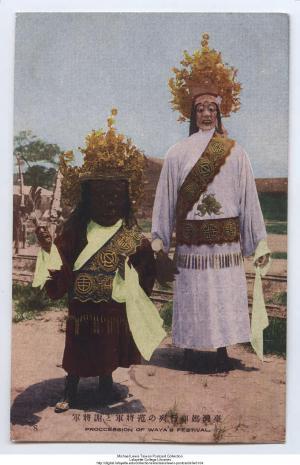
-the White Impermanence is often depicted with his tongue hanging out of his mouth (reminiscent of those who died by hanging) and a more cheerful expression, while the Black Impermanence is dark/blue-faced (reminiscent of death by drowning) and relatively more grim and fierce.
-the White Impermanence is also worshipped as a god of wealth by some.
However, outside of these bullet points, their tales and trajectory of development are a fascinating rabbit hole. I'd call them thorough folk gods, who evolved out of the greater existing character archetype of "ghost bureaucrats fetching people to the Underworld" and became their own unique characters almost entirely through folklore and oral legends.
So, without further ado, let's dive in.
Impermanence
The Great Spectre of Impermanence could arrive unexpectedly. (无常大鬼,不期而到) ——Sutra of Ksitigarbha's Fundamental Vows
To start talking about these two, we need to go into the general category of beings they separated out of later: Underworld officials.
Some conceptions of those petty ghost bureaucrats that mirrored living ones already existed in the Han dynasty; in burial goods and "grave scripts", there were paperwork dedicated to those officials, who were supposed to keep track of the Dead People Belongings List and maintain the segregation between the dead and the living.
Their characterization would get expanded a lot as time went on, in Northern-Southern dynasty and Tang legends, but this isn't an article about the ghost officials as a whole.
We are still tracing the origins of two specific ones, and to do that, we have to start with etymology——the "Wuchang" in their names.
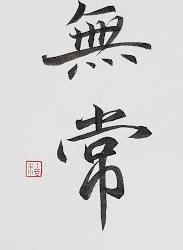
It is the translation of the Buddhist concept of "Anitya", referring to the impermanence of everything, which is always changing and dying and being reborn, with no constant to be found.
Yeah, you can see why a word describing the fleeting nature of life might eventually become associated with death and native psychopomps at some point in the Northern-Southern dynasty.
In the 39 chapter translation of the Dhammapada (interlaced with additional parables) by Fa Ju and Fa Li, the "Killing Spectre of Impermanence" (无常杀鬼) was first mentioned in the "On Impermanence" (无常品) chapter.
Another name for this grim-reaper-esque figure was "The Great Spectre of Impermanence", which appears in the quote at the beginning.
It appeared earlier than Ksitigarbha's Sutra, though: in another Northern-Southern dynasty translation of the Sutra of Golden Light, a Great Spectre of Impermanence was mentioned as this scary being that swallowed a king's younger son up whole.
By the Tang dynasty, the Spectre of Impermanence had appeared in both poetry and Buddhist text collections, as a generic name for the ghost that came to get you when you die.
However, the name wasn't exactly common or widespread, as made evident by all the N & S. dynasty and Tang legends about ghost bureaucrats where they were just referred to as, well, ghost bureaucrats.
Similarly, the Scripture on the Ten Kings doesn't mention anything about a Spectre of Impermanence. Instead, the second variant of the sutra says there are 3 ghosts working under King Yama——the "Soul-seizing Ghost" (夺魂鬼), "Essence-seizing Ghost" (夺精鬼), and "Spirit-binding Ghost" (缚魄鬼), responsible for dragging souls away in chains to the tree near the Underworld entrance pass.
(Their names might have corresponded to the idea of the Three Souls, each grabbing one of them, or the alternate division of Hun-Po plus the "vital force/essence".)
Right after that, however, they mentioned two demonic-looking birds sitting on the tree, one of which was named the "Bird of Impermanence", who would angrily scold and torment the dead for their misdeeds.
In this text, whatever the birds were, they were seen as a separate thing from the 3 ghosts that brought the souls of the dead to the Underworld entrance.
(A brief tangent about the 2 variants of the Ten Kings Scripture: the first could be found in the Dunhuang manuscripts, its name was 佛说预修十王生七经, and, as Teiser's translation of the scripture at the end of his academic book has showned, didn't have the 3 ghosts or the birds.)
(The variant mentioned above is 地藏菩萨发心因缘十王经, which is likely a Song dynasty Japanese apocrypha based on the first variant.)
Buddy Ghost Cops
When the ghostly officials of the Tang legends showed up, they could be alone, in pairs or in groups.
It was only in the Song-Yuan era that the idea of ghost cops showing up in pairs began to populate, and the first mention of the "Two Spectres of Impermanence" appeared in Vol. 3 of the Song dynasty 随隐漫录.
However, even without the word "Impermanence" attached, in various Song texts, the idea of there being 2 ghosts coming to get you instead of a single one or a group had already showed up with more frequency than before.
Come Ming dynasty, the Two Spectres of Impermanence got even more notable mentions in vernacular novels: a descriptive poem in Chapter 115 of Water Margins brings them up alongside the "Generals of the Five Paths" (五道将军), another native Underworld deity that showed up in Tang novels.
Plum in the Golden Vase, a.k.a. "that one Ming classic novel that often got censored and un-classic-ed because of its graphic sexual content", also has a folk Precious Scroll singing session (a story within a story, basically) that mentioned them.
In this story, King Yama sent a pair of "Impermanence Spectres" after Lady Huang, the protagonist of the scroll, who were also referred to as "Divine Boys/Acolytes of Good and Evil".
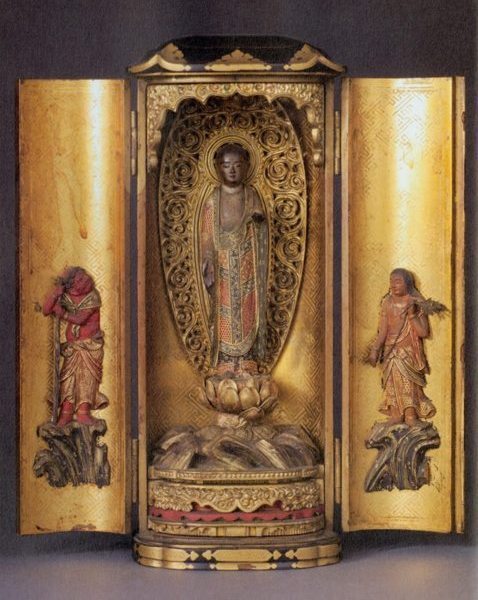
Now, the Boy-Acolytes of Good and Evil (善恶童子) were a pair of existing Underworld deities that had appeared in Dunhuang manuscripts and Ksitigarbha-themed artworks, responsible for recording the good and bad deeds of people respectively.
Their first mention was in the Tang translation of Surangama Sutra, and according to the second variant of the Ten Kings Scripture, the one recording bad deeds was said to look like a Raksha, while the one responsible for good deeds just looked like a regular divine acolyte.
Plum in the Golden Vase might have briefly aluded to that quirk too, in the story-within-a-story, where it was said that "Good people are welcomed by the acolyte(s), while bad people get the Yaksha(s)".
In the earlier Song dynasty compendium, Yijian Zhi, there are also mentions of two kids leading a fortunate guy's soul out of the Underworld, as well as showing up to inform some guy's wife that her days were numbered.
The second story is kinda funny, because after she had pretty much rolled over and accepted her fate, the two kids suddenly returned and were like "Excuse me, was Zhao your maiden name, or your husband's?"
Upon being informed that it was the latter case, they were like "Dangit, almost got the wrong person." Immediately after they left, another woman in the neighborhood whose surname was actually Zhao died.
Both stories do not use the specific name of "Acolytes of Good & Evil" for them, though, nor are they described as recorders of good and evil deeds.
For all I know, these two kids could be just like the pair of "young boys in blue robes" (青衣童子) who led Taizong into the Ghost Gate and the Underworld proper in JTTW Chapter 11: generic ghost workers.
But in Plum in the Golden Vase at least, they seemed to have been absorbed into the larger category of the Impermanence Ghosts, even though the Impermanence Ghosts still weren't their own characters yet, or gained any iconic uniforms.
Rather, it's more that 1) the catch-all name of "Impermanence" has become somewhat widespread for the generic ghost cops, though not yet universal, and 2) the Underworld apparently has a buddy-cop system in place now, where there had to be two ghostly officials for every newly dead person.
Psychopomp Outsourcing
In the late Ming and Qing dynasty, we got another twist on the Wuchang thing: Zou Wuchang, literally "Walk as Impermanences".
I've talked before about the early version of Taizong's trip to the Underworld, where Cui Jue/Ziyu, instead of being posthumously made a ghost judge, was a living official working part-time for the Underworld.
Well, Zou Wuchang is similar, but less prestigious, and you don't get paid either. The Underworld is short of hands (somehow), so they just grab a random living person and be like "Go fetch dead people for us."
The earliest mention of such a tradition in the Ming dynasty 语怪 placed the custom in Fengdu, the famous "ghost city" of Sichuan.
According to the text, when someone's soul was yanked off its streets to work as part-time psychopomps, they just fainted on the spot, and would revive after a few hours or overnight. The phenomenon was so common, the locals weren't even shocked, nor bothered getting them any medical attention.
Yuewei Caotang Biji goes further into the rationales of why Underworld needed those living conscripts. Apparently, all the living people clustered around a sickbed created a blazing aura of Yang, which certain venerable/fierce/brutish individuals also possessed in abundance, and was anathema to the ghost cops.
They were beings of pure Yin, after all, while the conscripts, whose bodies were Yin but still had plenty of Yang-aligned Qi, didn't have to worry about that.
Zou Wuchang was also not gender-exclusive, and there were mentions of multiple female conscripts in Qing legend compendiums.
Also, though the recruitment was forceful, you could actually retire after serving for a number of years——in one tale from 庸闲斋笔记, a woman fought the conscript for her mother-in-law's soul, who took pity on her and reported back to the City God.
In response, the City God said he'd send a report to Yama to see if she could be spared, and also released the conscript from her duty on account of her kind heart.
The popularity of this tradition across multiple sources and a long stretch of time signalled that, to an even greater extent than before, the ghost cops weren't generic ghost cops no longer: they are The Impermanences, which is only a few step away from developing into their own characters with unique iconography.
Black and White
First: where did their signature robe colors come from?
According to the first variant of the Ten Kings Scripture, officials under the Ten Kings were supposed to be dressed in black robes, riding a black horse, and carrying a black banner.

But in Tang folklore compendiums, that dress code wasn't a thing at all. A Taiwanese paper actually goes through tales of ghost officials inside Taiping Guangji where their appearances were described, and counted 22 cases of them wearing yellow robes, 7 cases of red robes, and only 8 stories involving ghost officials in either black or white robes.
Though ghost officials in black as well as white robes never appeared in the same story, they did have two things in common: 1) they tended to be quite tall, and 2) almost half of them were carrying weapons of some sorts.
The very late Ming/early Qing novel, Cu Hulu, also has a character ask Bodhisattva Ksitigarbha a bunch of questions in Chapter 12.
One of them was about the discrepancy between the depiction of Underworld officials in temples and the ones he personally saw, and he mentioned that the statues of "Impermanences" were 1) dressed in mourning robes and 2) about a Zhang and two Chi (3+ meter) in height.
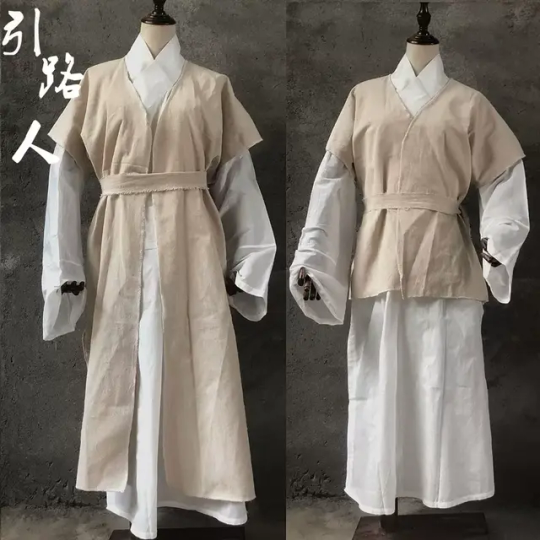
Which suggests that, by the novel's time, the ghost cops had already gained a set of uniforms, one associated with funerary affairs.
(Also: I love Ksitigarbha's answer to that particular question——"Yeah we used to have a really tall ghost cop like that, people just call him 'Wuchang' because they don't know what the heck he is. Also, Impermanence isn't actually a real name, it's a concept.")
However, as far as I know, the earliest mention of a pair of ghost cops, one in white and one in black, was in Vol. 19 of Yuewei Caotang Biji. And the story is quite funny.
Basically, this Sun guy was temporarily residing in someone else's house, and the host's mother was severely ill. One day, the family servant boy carried in some dinner for him, and because Sun was busy with something else, he told the boy to put it on a nearby table in another room.
Suddenly, a white robed guy just appeared out of nowhere and entered the house, followed by a short black robed guy.
Sun hurried into the room, saw the two guys stealing his dinner, and angrily yelled at them. The white robed guy noped out of there, leaving the black robed guy behind and hiding in a corner, unable to exit the room because Sun was blocking the door.
He kinda just sat outside and kept an eye on them for a while, before the host of the family suddenly showed up, telling him that his mother had just spoken.
Basically, the ghost officials had come for her, and one of them happened to be cornered in the room by Sun, so would he please move? She didn't want to be punished for showing up late.
The host didn't know if it was true either, and was just going out there and checking. But the moment Sun went and sat somewhere else, the ghost in black scampered out of the room. Soon afterwards, wailing began to come out of the mother's room, suggesting she had been taken away.
As hilariously pathetic as these two unnamed ghost cops are, the only thing connecting them to the Heibai Wuchang of much later times is their robe colors, and the black-robed one being short.
There are no tales featuring both 1) a pair of ghost cops in black and white, and 2) the pair being referred to as "Impermanences", though.
The middle-late Qing stories that do refer to the ghost cops as such tend to only feature a single Impermanence: unnaturally tall, dressed in white robes and hats, either holding a fan or carrying strings of paper money on his shoulders, sometimes bleeding from his eyes or nose/mouth.

(Yep, you know how the White Impermanence is often seen as the older of the two sworn brothers? As far as their historical existence goes, he really is the older guy.)
It was in the 19th century 醉茶志怪 that we saw the first signs of the two converging. In the three stories with "Impermanence" in their titles, two featured the "white-robed ghost cop in tall hat" alone, one of which described him as looking like a 10+ years old kid, standing at the side of the road like a temple clay statue.
The third story, however, featured a sighting of two giant ghosts, one in white and one in blue/green, near the City God's temple. Out of the four people involved in the encounter, three died after a few days, and the only survivor was the one who had his line of sight blocked by the palaquin.
How did 1 become 2?
How did the single unique Impermanence become the Black and White Impermanences?
Well…it's a complicated question with no definitive answers. We know that in the (probably Qing dynasty) Jade Records, there are already mentions of a pair of ghosts called Huo Wuchang ("Life-is-Impermanent" or "Living Impermanence") and Si Youfen ("Death-Has-a-Part").
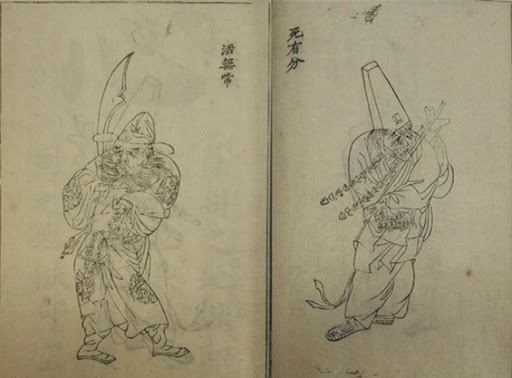
The former wears a black official hat and formal robes, holds brushes and papers in his hands, with blades on his shoulders and torture tools on his belts. He has big bulging eyes and is often laughing.
The latter has dirty, bloodied face, wears a white robe, holds an abacus, carries a sack of rice on his shoulder and has paper money dangling in front of his chest like a necklace. He has a sad frown on his face and is always sighing.
As you can see, there are similarities, but also notable differences from the "iconic" Black & White Impermanences. Whereas the White Impermanence is usually depicted as the cheerful one in white robes, carrying an abacus and wearing strings of paper money, here, he is the sad and grim one.
Their jobs also differ: instead of fetching souls to the Underworld, in the Jade Records, these two are responsible for pushing the dead off the bridges after they have drunken Mengpo's amnesia soup, into the scarlet river so they can reincarnate.
Personally, I view them as a transistory stage between the "Generic Impermanence Ghosts" and "The Two Unique Psychopomps We Know and Love", one strand of the folk god evolutionary process that was captured in written sources.
A Japanese paper goes into another strand in the evolution: the addition of the Black Impermanence. Namely, he might have grown out of a ghost that commonly showed up in City God worship and parades, the so-called "Wall-touching Ghost" (摸壁鬼).
The claim was based on very late Qing newspaper illustrations, where the Black Impermanence was depicted as holding up his two arms like this:
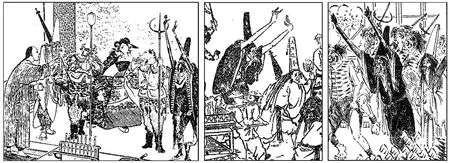
Which was a gesture commonly used by the "Wall-touching Ghost" during parades in the Jiangsu area, who also wore black robes and tall hats.
The author of the paper then dug into sources about the Wall-touching Ghost, and not only found records of the parades, but also a Qianlong era Mulian opera script, 劝善金科, that paired him together with the Impermanence Ghost as fetchers of the dead.

(The two were also given names in this opera: the Impermanence Ghost is named Ba Yang, and the Wall-touching Ghost, Wu Qi.)
Earlier mentions of the Wall-touching Ghost in Qing folklore compendiums, however, didn't depict him as a ghost cop. The story in 夜航船 just described it as a ghost thing that hid between walls and used its chill breath to suck up people's souls.
Another story in the 1878 浇愁集, even though it described the ghost more——dark-faced, holding its arms up like in the drawing, could turn into a cloud of black smoke and disappear into walls——still had it as your typical "ghost shows up, people die" ill omen.
So the paper's proposition is that, after the White Impermanence has separated out of the "Generic Ghost Cop Impermanences" and become his own thing, people in southern Jiangsu built on their existing Wall-touching Ghost and made him into the former's partner, absorbing most of his iconography in the process.
Similarly, the "tall and short" pair-up that was popular in Fujian and spread across Taiwan and SEA might also be a result of parallel local evolution, together with the name Xie Bi'an and Fan Wujiu.
Xie and Fan
Yes! At last, at last, we are getting to the most well-known and popular origin story, a.k.a. the Nantai Bridge Tale.
A summary: Xie Bi'an and Fan Wujiu were a pair of best friends/sworn brothers from Fujian, working as constables for the local magistrate. One day, while they were out on a mission, they saw a storm brewing. Xie went back to grab umbrellas while Fan waited for him under the bridge.
Unfortunately, the downpour soon began, causing the river to flood. Fan, unwilling to break his promise, continued waiting for Xie under the bridge and drowned. When Xie returned and saw his sworn brother's corpse, he hang himself out of guilt and grief too.
(…As a casual reader, I, always wondered why "waiting ON the bridge instead of under it" never crossed his mind as an option. Okay, sure, it was raining. But that's all the more reason to not stand under the darn bridge.)
Touched by their loyalty to each other, the City God/King Yama/Jade Emperor appoints them as ghostly constables, responsible for fetching the dead to the Underworld.
This story bears a lot of similarity to the fable of Wei Sheng in Zhuangzi. Basically, the guy made a promise to meet a girl under a bridge, the girl didn't show up, there was a flood, and, unwilling to leave, he drowned while still clinging to the bridge pillar.
Zhuangzi's opinion of the guy wasn't too high, because honestly, what a stupid way to die.
However, Sima Qian held him up as an exemplar of loyalty and keeping one's word, and the reading stuck. For later folktales about Wei Sheng as well as others that adopted the basic premise, like one tale in the 七世夫妻 story cycle, it also tended to get turned into a straight-up love story.
Though the Nantai Bridge Tale is the most popular version of their backstory, it's far from the only version. One version has them as Tang dynasty officials, working under the historical figure Zhang Xun, who died during the Anshi Rebellion.
While they were trying to get reinforcements, Xie was caught and hung on the city gate by the rebels, while Fan accidentally drowned.
When Zhang Xun was made a City God after the city fell and the rebels killed him, these two also became deified as his attendants.
In another version, Xie was a filial son with an aging mother, who had been wrongly imprisoned because of a friend's crime. During the Lunar New Year, Fan found him crying in the cell, and, upon learning about his sad backstory, released him secretly to visit his mother, on the condition that he returns after seven days.
However, his mother died soon after his return. Busy with her funeral, Xie did not return in time, and Fan, unable to answer to his superiors, committed suicide via drinking poison. When Xie returned and learned of the terrible news, he, too, hang himself.
And these three are far from the only known versions! Like, seriously, there are probably as many variations of the story as there are variations of the objects they held in their hands.
Though some elements stay more constant——using their deaths to explain their iconography, Xie being more commonly associated with the fan, umbrella, and abacus and Fan, chains, everything is subjected to changes and regional differences.
(For example, SEA oral legends tend to associate them with opium. Most of the time, they are constables or mercenaries employed to track down opium smugglers and other criminals, but some have them as Robin Hood-esque opium smugglers.)
Anyways, I hope this long post has offered some insight into the two iconic, yet also somewhat obscure ghost cops. I might add an "Appendix of Fun Facts and Tales" that doesn't fit into the main body of the post, but for now? That will be all.
May the readers who celebrate it have a nice Zhongyuan Festival.
Bibliography:
蔺坤:《无常鬼考源》
大谷亨:《黑无常的诞生与演变—— 以江苏南部的摸壁鬼传说为中心》
陈威伯、施静宜:《七爷八爷成神故事研究》
江義雄:《臺灣「黑白無常」與「范謝將軍」研究》
吳彥鋒:《臺灣七爺八���傳說及其與信仰關係研究》
中国国家博物馆藏《十一面观音变相》的阐释
劉榕峻:狂放不羈、怪異獨特:談香港藝術館展出的「揚州八怪」
Stephen F. Teiser, The Scripture on the Ten Kings and the Making of Purgatory in Medieval Chinese Buddhism
Fabian Graham, Voices from the Underworld: Chinese Hell Deity Worship in Contemporary Singapore and Malaysia
CBETA: 《地藏王菩萨本愿经》
CBETA:《佛说地藏王菩萨发心因缘十王经》
夷坚志/支癸07,“赵彥珍妻”
《金瓶梅词话》,Chapter 74
《醋葫芦》,Chapter 12
《劝善金科》Vol.5, Part 2
The Jade Guidebook: Appendices, translated by David K. Jordan
Journey to the West Vol.1, Chapter 11, translated by Anthony C. Yu
#chinese folklore#heibai wuchang#fan wujiu#xie bi'an#chinese folk religion#chinese underworld#cw: death#cw: suicide#hell#ghosts#ghost month#hungry ghost festival
143 notes
·
View notes
Text
warrior cats take that may be controversial in some circles but I think that the cats 100% can and do understand human swear words. This is a reasonable assumption to me. Most of the other invented cat words like twolegs or thunderpath exist textually to create a divide and sense of unknowing between the clan cats and human society. "Fox-dung" exists so they don't have to write the words crap and shit in a kid's book. The cats do shit. "Well etymologically they likely wouldn't have the same language" true but this book series is not written in a kitty cat conlang. You could say this about literally any word on the page. You know that's not why there's no swear words in warrior cats. You know there is a very glaring obvious reason (it is for kids) instead. "But they have their own swear words anyways so why do they need others" how delightful it is for them to have a more expansive vocabulary in that regard. It doesn't mean Yellowfang doesn't swear like a sailor offpage. You'll never prove to me that the cats don't swear until the next super edition where new side character kittypet joe calls the clan cats fucking bastard cunts and they go "i dont know what this means"
95 notes
·
View notes
Text
A Linguistic Analysis of the Spelling Names "Ania" and "Anya" (and the chapter and languages of Ostania)
This includes spoilers from Short Mission 11, or Chapter 90.1
It's not a secret that Anya's (Ania) name change was officialized along with Loid (Lloyd) and Yor (Yoru/Yolanda) in July 2019. I do recall that our loveable Forger family had different spellings in the early manga releases. Many believed that it was Endo-san's way to cover up the spelling mistake, but I believe that, whether or not the origin and/or intention was a mistake, it paved a beautiful opportunity for a deep dive into linguistics and character analysis on Anya Forger.
First, I'd like to address my thoughts on "ANIA" as the spelling. Here are a few of my impressions on this:
"ANIA" could be perceived as her original spelling because wherever she came from used this spelling.
"ANIA" could just be her limitation as a child when it came to spelling her name.
"ANIA" could be an acronym from her lab that probably served the purpose of her existence.
"ANIA" could be the name of her mother/creator. And she was subjected to share the same name of her creator for "sourcing" purposes.
"ANIA" when applied to numerology number, reinforced her code name which is 007 (which is super meta to me, but probably is a coincidence because we all know 007 was Endo's way of referencing James Bond). S/O to @momentocollector for sharing this!

Second, I'd like to address "ANIA" as an identity for our precious baby girl.

"Ania" is the chosen spelling. This could possibly mean that this is her real name and how it should be spelled (You, as the owner of your name have every right to decide what your name should be, spelled, or pronounced after all).
"Ania" could possibly be an influence of either her mother-tongue language's spelling.
"Ania" could possibly be due to her limitation of spelling. (I don't think she is aware of how her name should be spelled.)
Recall that Yor carved out Anya's name as "Ania" and didn't question it. This could be a reflection of Yor's own lack of familiarity of Ostanian orthography since she is academically limited, and she would have listened to how Anya would have wanted her name to be spelled. Furthermore, this tells me that Yor's absence of questioning reflects that she accepts her daughter no matter who she is, be it "Ania" or "Anya".
Third, I'd like to address "ANYA" as her name's spelling.
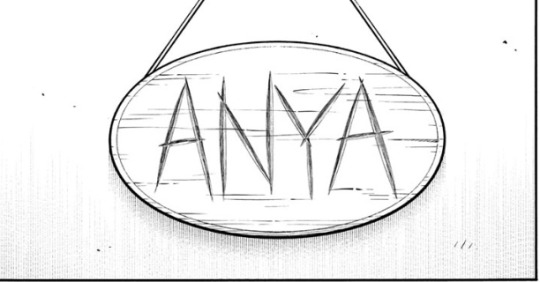
"A-N-Y-A" is the spelling that her papa gave her, which tells her that she can now be on the same playing field as her parents. Their names and titles are all "masks" in this masquerade that they call "Forger". So, to little Anya, it means that she finally belongs with someone. Anya has essentially found "her home".
We also know that Franky did do a lot of paperwork and found that "Anya" is the spelling that was written down on her adoption papers. This reinforces that "Anya" is the standard Ostanian orthography of her name.
I perceive Loid as a person replicating the "average Ostanian" (since this is a deep cover mission after all), so to also tell her that her name is spelled a certain way reinforces that she has a new identity as an "Ostanian child". (I find this quite ironically poetic because it's a "fake man" giving a "fake name" to his "fake daughter").
I also see that when Anya's eyes light up, it could also mean that this new identity in her spelling change meant she was finally liberated from her days as a lab experiment and living in an orphanage.

Fourth, I'd like to address spelling etymology.
Since I'm not a Japanese linguist expert, I found @connoisseursdecomfort post to be quite educational when it came to Japanese spelling.
What we learn from the above post is that "Ania" is an acceptable name spelling in "Old Japanese". But as time progressed, the spelling changed to "Anya" which is the modern-day spelling of this name (this may tie into Anya's character lore).
We can track "i" becomes "y" in the evolution of the alphabet from Phoenician (c. 1000 BC) to Archaeic Greek (c. 750 BC). S/O to @rachellysebrook for this link. (Again, what this reinforces is Anya's background with an unidentified mother country/mother tongue language).
Another thing is that Yor Forger did not react to the spelling of "Ania". It could possibly be that she recognized Anya's limitation, given that her daughter already had poor scores since her admission.
We also learned that Yor, a real Ostanian, seems to be limited with Ostanian orthography which is most likely due to her dropping out of school to take care of Yuri (fake Ostanian /j). From her interaction with Anya, off-screen, it appears that Yor seems indifferent to spelling standards of names (Which is nice! She is subtly against society's norm and I love her for that). Had she been aware of the spelling, she would have been the one to ask instead of Loid. (But again, it must be Loid because it's poetic and has a much more meaningful interaction between "Loid" and "Anya").
Fifth, I'd like to address the name's (possible) impact on character purpose in the story.
"Anya" means mother in Hungarian (S/O to @httplovecraft1890. This inspired my thoughts on "Ania" as a name in the lab). Could this possibly be an inspiration or coincidence? It could be a stretch, but perhaps Anya's purpose in the lab is that she's a "mother weapon" for war.
"Ania" means "gracious" and "merciful" according to Google. Which makes me think that the lab scientists went with this name because it would represent her purpose as a weapon of war. Perhaps Ania becomes the "truth serum" and could be seen as the "angel of death" because she knows the war captor's thoughts and inevitably they are executed (a possible headcanon).
Sixth, I'd like to discuss the factors of the mysterious "unidentified language".
Anya did use "oui" in the anime when Loid had adopted her. This automatically made me think her possible origins could be French, but it could also take another step back in the language family: Romance. What makes this work is that we treat "Classical Language" as a dead language based on what we read/saw in the manga/anime like Latin. Anya has an innate potential to be bi-/multilingual.

Bonus: Seventh, I'd like to talk about the languages in this anime (This is a bit of a ramble but since we're talking about linguistics, I thought why not)...
Based on the dialogues spoken in the anime, we can confirm that English exclamatory (Oh my God, Goddammit, Shit, Wow, Elegant, etc.) and the Japanese language are the main components of the Ostanian language. This is reinforced by many characters who have used English expressions (Loid, Yuri, Yor, Anya, Damian, Henderson, etc.)

What does bug me is whether or not "oui", a French exclamatory, should be categorized as part of the Ostanian language or if that should be categorized for Anya's hidden lore. The reason is that when Loid/Twilight heard Anya say "oui" in front of him, he did not question it. (Perhaps he was too tired to process this, or he excused it as something Anya could have seen on TV and is merely mimicking. I really don't think Twilight would be the type to excuse this realization had he not had the aforementioned state of mind). I'm leaning more towards the latter as this is from Anya's mother tongue language.
In conclusion (or tldr;): "Ania" may be her real name, but "Anya" is her new identity as part of the Forgers.
If you read everything, thank you for your time! The linguist in me is so happy that Endo-san is steeping his foot into linguistic territory. As short as this chapter was, it said A LOT to me linguistically and provided more details to the scraps of lore that we know of Anya but it also tells us a bit more about Yor, Loid/Twilight, and Ostania.
#spy x family#spy x family spoiler#spy x family chapter 90.1#Anya Forger#Ania#Anya#name analysis#manga chapter analysis#analysis#Spy x family Analysis#linguistics#orthography#loid forger#yor forger#scarlymadeathing#scarlydidathing#scarlywroteathing
292 notes
·
View notes
Text
☆━━━━━ ⋆⁺。˚⋆˙‧₊☾ ◯ ☽₊‧˙⋆˚。⁺⋆ ━━━━━━☆
✩ ‧₊˚ ⌞ DOLL THEORY ⌝

sampo analysis m.list
— what the stars reveal: theoretical speculation, interpretative analysis, waxing poetic, red string conspiracy theory board in full swing
— word count: 6.1k
— overview: (as of 2.6) going out with a bang by outlining my doll!sampo theory, including evidence from the simulated universe, limited-time events, dialogue, and more! not many photos in this one, since i’ll just be referencing the other analyses i’ve already completed — you can visit the masterlist here.
☆━━━━━ ⋆⁺。˚⋆˙‧₊☾ ◯ ☽₊‧˙⋆˚。⁺⋆ ━━━━━━☆
✩ ‧₊˚ ⌞ DISCLAIMER ⌝
When discussing theoretical speculation, I do not believe these events to be set-in-stone or even canon, only that this is an interpretation of events I am very interested in talking about! I have no idea if any of this will actually end up being true, but it’s fun to speculate. Even if it all is proven false later on, I still think it’s a fun idea to play around with for AUs and the like! Enjoy!
✩ ‧₊˚ ⌞ INTRODUCTION ⌝
Doll Theory is the name I have ascribed to my theory that Sampo is a creation of Aha similar in function to the doll in the Aha Stuffed Toy occurrence within the Simulated Universe. This includes sharing Aha’s physical appearance (the silhouette), being created to vent extreme emotions on, and being betrayed or discarded by Aha once the Aeon was done with him. I often imagine Doll!Sampo to be or have been an Emanator at some point as well.
This theory can easily run in sync with other Sampo theories, such as Aha!Sampo, Masked Fool!Sampo (canon), and the aforementioned Emanator!Sampo. Sampo as a protector of Belobog, Sampo as “Mr. Cold Feet,” Sampo as a worker (or boss) disillusioned with his job, Sampo who wants to help the Trailblazer — it all fits here!
(Note: reading my other analyses isn’t needed to understand what’s going on, but I figured I’d include links in some sections for those interested!)
✩ ‧₊˚ ⌞ EVIDENCE ⌝
Related Analyses — Simulated Universe, Kit & Abilities, Divergent Universe, Name & Etymology, and Notable Topics. Masterlist link!
Aha Stuffed Toy
The main piece of evidence that sparked this theory is the Aha Stuffed Toy occurrence in the Simulated Universe. Summarized, the occurrence details the existence of a toy — or “doll” — created in Aha’s own likeness for the purpose of venting extreme emotions on. Aha wishes to see Themself beaten up, and is not involved in the “quality control” process. Upon interacting with the doll as a player, you have two options: pat it lightly or hit it hard. Both options have a random chance of granting varying quantities of Cosmic Fragments, or none.
In certain outcomes, the doll is broken, destroyed, or its head explodes. In the case of the Elation option in Gold and Gears, the doll even gains sentience and steals your Cosmic Fragments, accompanied by the line “Only Aha knows the secret.”
I connect this to Sampo mainly through his trade, affiliation with Elation, and namesake. His trade of being a con-man centers much of his actions around money — whether giving or taking — much like the doll awarding or stealing Cosmic Fragments. With Cosmic Fragments as a stand-in for in-universe currency, it’s easy for me to see Sampo as serving a similar function concerning the flow of money. Additionally, he is the only character so far connected to both the Elation and this amount of currency-based identity.
However, my main idea comes from Sampo’s namesake — a Finnish mythological artifact known for distributing wealth upon others. Not only was the Sampo forged by a god (mirroring the creation of the doll by Aha), it was tied to granting others wealth (Cosmic Fragments), conflicts were fought because of it (small link to the “conflict” of beating up the doll), and it was ultimately destroyed (much like the doll breaking or its head blowing up). That, paired with the cryptic line “Only Aha knows the secret” that causes the doll to become sentient and steal our Cosmic Fragments (much like Sampo cheats others out of their own money), leads me to interpret this occurrence as being intertwined with Sampo’s own identity.
Curio Hacker
Curio Hacker is the main Sampo occurrence I’ve seen people talking about, and for good reason. The “blue-haired entity” is an immediate connection, and its general demeanor matches Sampo’s.
However, my main sources of evidence come from the Curios here. Organic Heart and Mysterious Magnetism, to put it simply, carry heavy themes of experimentation, creation, and the blending of multiple objects or concepts into one before abandonment. If we look into the question of why Sampo might be trying to replicate these Curios and how he even managed to access the Simulated Universe in the first place, we can arrive at the conclusion that these two in particular have some sort of meaning or connection to who he is or what he is trying to accomplish.
Given the Curios’s heavy focus on creation and combination, I don’t think it’s too far of a stretch to assume Sampo may be a creation or “combination” himself — likely a bridge between the mortal and immortal as an Emanator, insentient and sentient consciousnesses as a Doll. He is an enigma, just like Organic Heart and Mysterious Magnetism.
The *Perfect* Grand Challenge
Another occurrence that is heavily Elation-coded, The *Perfect* Grand Challenge once again showcases toys and dolls in the spotlight, this time inside an arcade machine. Not only does this occurrence have several nods to a “programmer” (linking to the blue-haired entity in Curio Hacker), but it also features a doll whose head blows up after venting extreme emotion.
My main takeaway here is the existence of multiple dolls, which may imply that Sampo is not the only one of his kind, merely another step in his creator’s pursuit of “perfection”. Although the concept of “perfection” doesn’t seem to fit with Elation that much for me, I could still see Aha becoming enamored with the idea of a “perfect self,” if only for shits and giggles.
Masked Fools Boundary Equation
In the Divergent Universe Masked Fools Equation Expansion, triggered by collecting sixteen Elation blessings, part of the story sees our point of view character (who I interpret to be Aha) drinking a beverage concocted with “fruit extracted from bitter hatred felt after falling from great heights.” This is more a combination of Emanator! and Doll!Sampo to me, since I connect “fruit” to “Organic Heart” which is part apple, “bitter hatred” to Sampo’s Eidolon “The Deeper the Love, The Stronger the Hate,” and “falling” to be a kind of betrayal or violence associated with both the doll and Sampo as a character.
My guess is that Sampo may have previously been an Emanator, but had his status revoked, causing him to “fall from great heights.” In this way, the doll would also be harmed, allowing for a “reward” — or in this case, a nice amusing beverage — to find its way into Aha’s possession. This could also be seen as Aha growing bored with Sampo, essentially discarding him like a used toy.
Jester of Anatta
I’m putting this here because I feel like every single word of the original text is important!
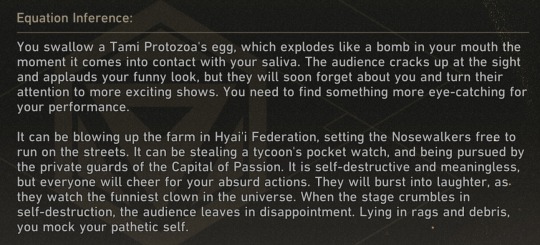
This is a four-star equation combining blessings of Nihility and Elation. Not only is it a four-star like Sampo’s character rarity, but it sits in the exact intersection of his affiliations — his playable path being Nihility while his in-game affiliation is with the Masked Fools, an Elation faction.
— Exploding in the face / head area.
— Explodes “like a bomb” — his ultimate uses a bomb to hide his face and he has a lot of bomb imagery surrounding him.
— The audience laughs and “gains something” from his pain, though he is soon forgotten.
— Intentional self-destruction for others’ gain.
— Stealing, being pursued by private guards, blowing things up — all acts for attention, all acts Sampo has canonically committed.
— Reference to the subject as a “clown,” mirroring Sampo’s “Clown’s Items” from Penacony.
— “Lying in rags and debris, you mock your pathetic self.” Debris implies physical acts of destruction, rags implies a loss of wealth and status.
— The abandonment of others.
The main connections I make are to the doll’s head blowing up, the abandonment themes of Curio Hacker’s Curios, and a type of “reward” being gained from physical pain. The extreme emotion in this case not only would be Elation itself from the audience, but the intense self-mocking and pain of the “clown.” After all, Aha Stuffed Toy never said the emotions being vented had to come solely from the outside — it’s possible that stress or hatred turned inward could do the same trick.
Also, the “rags and debris” implies a type of being spent, perhaps something akin to the Sampo bleeding out all its wealth to others only to be left behind as everyone moves on.
Other Evidence
— The Simulated Universe occurrence Ace Trash Digger is also a huge connection; here’s a short post where I detail my thoughts on it.
— Additionally, here is my post on the Ship of Fools Unknowable Domain occurrence, as it pretty blatantly references Sampo (and Sparkle!) as well.
— In the trash can event, Sampo’s stage “Hazardous Waste” directly refers to an effect that causes him to be “beaten up” so he regenerates energy and attack. “Hazardous Waste” may also be a reference to his abandonment or “fall from great heights,” making clear that even though he has been discarded like the toy he was made to be, he is still very dangerous, much like the venom-tipped fangs on the shoulder of his outfit.
— Sampo’s downed pose is unique among Star Rail characters, looking like a doll folding down to protect his face.
— His line when hit by a heavy attack — “Hey, watch the face!” — could be another extension of him trying to protect himself from “breaking”.
— The Noblesse Worm Aha made an Emanator once. Since we know that Aha is fast and loose with who They promote to (and demote from) Emanator status, I don’t see it as too far of a reach to assume They might turn one of Their own doomed creations into an Emanator for the cruel, hilarious irony of it all. (And for that yummy beverage, of course.)
— The Sampo of Finnish mythology is huge here, since its narrative, function, and eventual fate is directly mirrored by the Aha Stuffed Toy occurrence.
— This line from a starskiff on the Skysplitter:

(Not directly a piece of evidence, but it summarizes a lot of my feelings on Sampo’s sentience.)
— “Eyes of the Prey” is a light cone that positions Sampo as both predator and prey — and Emanator!Doll!Sampo would fit this perfectly, the Emanator in him being the predator and the Doll in him being the prey.
— Sharing an appearance with Aha (“created in Their likeness”): red on the outside of his outfit much like the oranges and reds of Aha’s masks, similar silhouettes, not visiting the Express due to potentially being recognized from Aha’s time there, Aha being referenced but not described in the Astral Express dream bubble because They may look similar to someone we know and would recognize (like Sampo) — even shares similar vocal quirks like referring to himself in third person.
— Being beaten up for rewards & venting of extreme emotion — usually no “nice” dialogue options to him in-game, basically a punching bag for most people around him like Topaz collecting his debt in her trailer, people are just mean to this man for no good reason honestly. I’d like to think this is because the universe literally dictates them to be, as that is his purpose.
— Sampo has several unique “quirks,” such as not leaving footprints, that imply he may be different from a normal being. As a creation of Elation, this could be side effect of his existence (or potentially his attempts to subvert it).
— In the Tatalov sequence, Sampo directly refers to a “truth” he is trying to reveal. It seems he can’t tell us upfront, so this may be the “secret” only Aha knows.
— Sampo is well-known for scamming people and essentially stealing their money, much like the sentient doll who steals our Cosmic Fragments in Aha Stuffed Toy.
— The doll also makes a direct fourth wall break by looking at us, both the Trailbazer and by extension the player, which is something Sampo has also done by looking at the “audience” and addressing us.
— Jester of Anatta, the doll, and many other pieces of evidence listed so far have heavy themes of voyeurism looking in on another’s pain.
— The “quality control” mentioned in Aha Stuffed Toy carries similar themes of experimentation and creation as the other mentioned occurrences. Given that They are not involved in this process, this could also link to abandonment and even the idea of Sampo being “buggy,” hence the hacker in Curio Hacker and his lack of footprints.
— Additionally, an Intellitron NPC in Dream’s Edge named Kirk talks about Asmon Rim, an Elation planet that began to treat other lives as toys in their pursuit of the Laughter. While I’m not sure how much this factors into Sampo’s story given the existence of Kalevala (the planet) as a likely origin for him, I still feel it’s important to mention. Asmon Rim definitely lines up with the overall dehumanization of the Aha Stuffed Toy, although it does lack the direct involvement of Aha. Perhaps Sampo found himself there somewhere along his journey, or perhaps his betrayal occurred there or something similar. Food for thought!
✩ ‧₊˚ ⌞ INTERPRETATIONS⌝
Related Analyses — Eidolons, Penacony Voicelines, Simulated Universe, Outfit & Design Motifs, and Notable Topics. Masterlist link!
Beyond just evidence, Doll Theory lends itself to certain interpretations of canon, mainly the many mysteries surrounding Sampo and his role in the story.
Tatalov
While the Tatalov plotline still confuses me in general (as I feel it was meant to), the closest interpretation I have for it under Doll Theory is that, since we are in Sampo’s dreamscape, the plot itself is meant to mirror Sampo’s own existence. As he says after Firefly interrupts the dream bubble, he’s trying to “reveal” a specific truth, which is likely something to do with his identity or role in future events.
In this case, I see the trash cans as being stand-ins for either other dolls or Belobog’s people, with the giant Sampo at the end equating to the Sampo we know. It may be trying to point us towards Sampo’s status as an Emanator by enlarging him to a size reminiscent of Phantylia, or imply he is attempting to go against his creator — likely Aha — through the lines “Become the garbage king / though the cans have long been broken.” (Also note the specific use of the word “broken” here.)
Again, Tatalov still confuses me quite a bit, so I feel the whole thing could be symbolic of Sampo’s backstory as a doll and goal of gaining power to inspire others to fight back, or it could also be symbolic of him protecting Belobog (or both!). The jury’s still out on the specifics.
Eidolons
Although I already covered Sampo’s eidolons in its own analysis, my interpretations have changed a little, so here I am to quickly go over each eidolon for Doll Theory.
— Rising Love: Rising into being, creation. “Love” could stand for Elation itself, Sampo’s early love for Aha / his purpose, or Aha’s “love” creating him. Also could be indicative of rising to Emanator status. Also also, could be the “rising love” of an audience becoming enamored with him / entertained by his suffering, much like in Jester of Anatta. He is facing away from the viewer, just another faceless doll. (This eidolon may also be referencing a period of time where Aha becomes “re-interested” in Sampo, meaning Sampo is the recipient of this “rising love” coming from Aha after being discarded for a long time.)
— Infectious Enthusiasm: Doll!Sampo as an extension of Aha, being made in Their image. Aha is known for having “infectious enthusiasm” specifically, so this is probably the point Sampo is closest to Them. Sampo as an Emanator would also fit this idea. Being surrounded by Elation, specifically of the intense kind. The constant need to perform. Now that he has been lifted high as an Emanator, we focus on his eye, a small yet more identity-laden part of him — he is not “just another plaything,” or so he thinks.
— Big Money!: Tie-in to the doll bestowing wealth. He grants currency onto others; his existence is full of it. The audience is scoring “Big Money!” by venting on him or watching him suffer, and if he is being self-destructive, he may be receiving it too. May also be indicative of a turning point, a shift in understanding of his own purpose and identity given the next eidolon. Here, he is seen flipping through bills with a smirk; this may be when he begins using earning money as a coping mechanism, or a way to take back autonomy for himself.
— The Deeper the Love, The Stronger the Hate: The dichotomy of his existence; the irony of a doll. Being showered with so much love by others, only to realize that love is conditional on your pain. The more the audience loves, the more Sampo hates himself for being helpless, for being miserable. The more Aha bestows Their “love,” the more Sampo begins to resent his creator for creating him. The more Sampo allows himself to feel love, to feel Elation, the more that hatred festers within him, the idea that he must be made for more than this. He is smiling here — attempting to transmit the love, the enthusiasm, the Elation his purpose demands — but he is unable to hide the hatred hiding behind his dulled eye. (This could also be seen as the moment of “betrayal” where Sampo loses his Emanator status, effectively being robbed of the only power or agency he had.)
— Huuuuge Money!: Sampo has begun to get used to the wealth constantly spilling from him, although it does not change the feelings in his heart. While the money flows more than ever, he enters a cycle of self-destruction, tying his identity to earning money himself, leaning into the con-man persona. The name also implies a heightened intensity of him either making money, or others making money off of him, which would be directly correlated with increased pain or suffering. He stares head on, somewhat tiredly.
— Increased Spending: Likely referencing his attempts to “hack” the system or bypass the nature of his own existence, paying a cost to reap a greater reward later on. To me, this seems both like a calculated plan, but also like spinning out of control, almost like a gambling addiction. He looks more serene in his art, though, so maybe he has found some sort of peace in his attempt to break free.
Overall, this interpretation has a similar track as my other analysis, going from rising to Emanatorhood / dollhood through creation by Aha, being surrounded by Elation and full of it, and being closely intertwined with currency, to a “betrayal” or slow-building hatred of the self or others, which then transitions into an even bigger spiral of planning, spending, and suffering.
Clown’s Items
This could reasonably go in the evidence section, but it also has interpretation so I figured it could go here.
The Clown’s Items — being the items Sampo asks for in the Penacony main quest — are as follows: Moment of Betrayal, Cloud of Doubt, and Everlasting Hatred, in that specific order.
The cool thing is, those are actual consumables on the game! Although I don’t believe they were created by the devs with Sampo specifically in mind (as some of them seem similar to other characters, such as the blade stabbing through a rose that reminds me of Argenti), I do believe they were included by name in this quest to imply something specific.
(Note that these consumables are focused on attack / crit increases and damage reduction.)
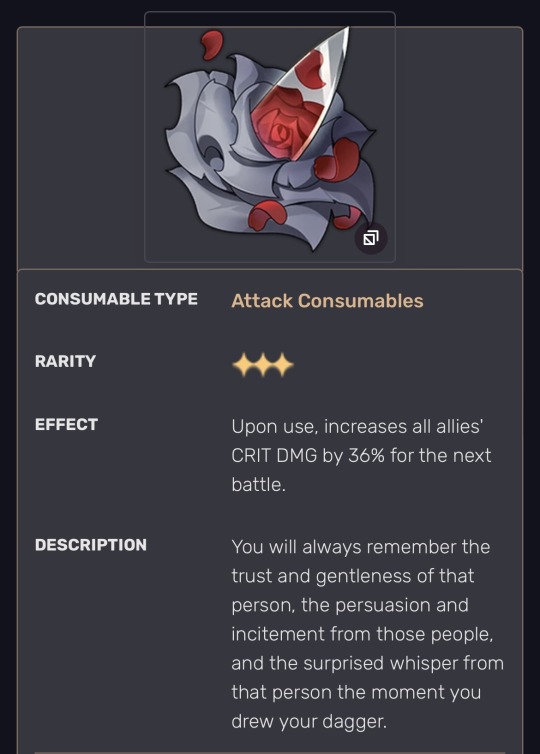

The art is of a knife stabbing a dead rose with vibrant red petals in the reflection. This can connect to the red roses in Sampo’s ultimate. “Moment of Betrayal” also increases Crit, much like Sampo’s attack increases after being beaten in the trash can event.
The description could be a connection to the audience from Jester of Anatta / the people seeking wealth from the doll (“persuasion and incitement from those people”).
The betrayer and betrayed could be twofold: Sampo betraying Aha, subverting his purpose through sentience and attempting to break free in a moment of surprise, or Sampo himself being betrayed, potentially by someone within the Masked Fools or even by Aha Themself.
I read this as either Sampo betraying Aha, his creator — “Et tu, my child?” would be a direct reference to Aha as Sampo’s creator or “parent” — or the Masked Fools betraying Sampo — the line would now be Sampo speaking to those below him from the status of Emanator. It may even be a combination of both, as Emanator! and Doll!Sampo often go hand-in-hand in my mind.
Perhaps Aha betrayed Sampo by taking away his Emanatorhood, which the Masked Fools then made worse in Sampo’s time of need, while Sampo now plots to turn the tables and betray Aha in the future. Who knows? It’s all speculation!
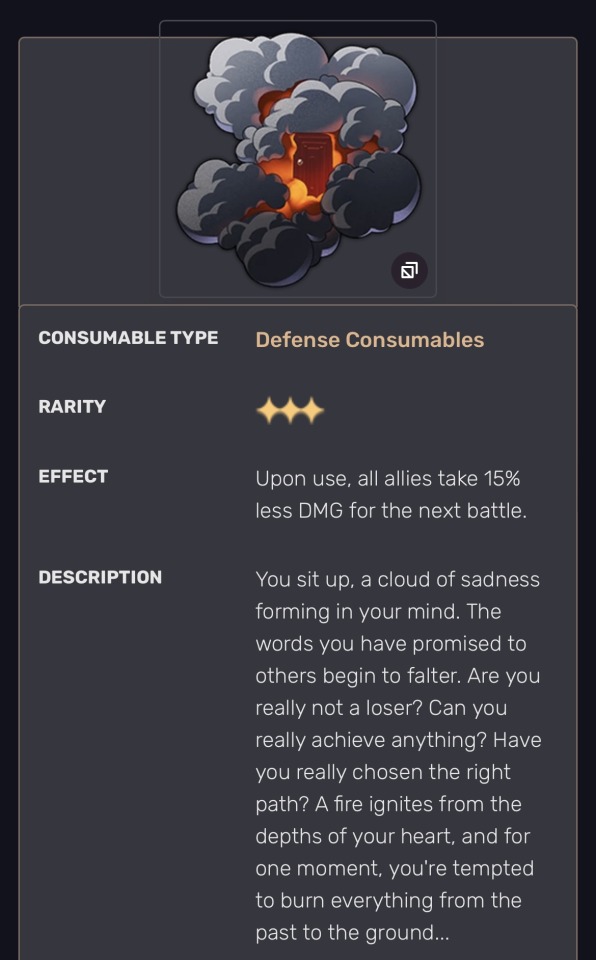

(Defense and taking less damage may tie in to a form of self-protection, of finally distancing oneself from hurt.)
The Cloud of Doubt focuses on a burning door amidst deep gray smoke. This could be a reference to Sampo’s old life burning down around him after the betrayal, obscuring itself in the haze of an uncertain future. “Doubt” is also what likely set in after everything happened, perhaps even a seed in his mind for a long time as he performed and bled and suffered.
As an Emanator, he likely prided himself on his confidence, but the description of the item may be his internal self talk later on. If his existence was a lie, if there was no greater purpose to his suffering, then what was the point? Why would anyone trust the self-pitying Jester of Anatta or the false bravado of an Emanator or the sad life of a doll only made to be broken?
Then, he was likely tempted to burn. The hatred has already begun to set in, and he decided on whatever plan he was going to set in motion. The house he’d lived in was burning, so why not destroy the house? He wasn’t planning to live there anymore anyways.
“And that spark had already been ignited long ago.” The spark, a chorus of laughter looking in. The spark, a thousand cuts. The spark, a shallow ember set before a door, a bird with clipped wings, a puppeteer’s string pulled taut, taut, taut, until finally… snap.
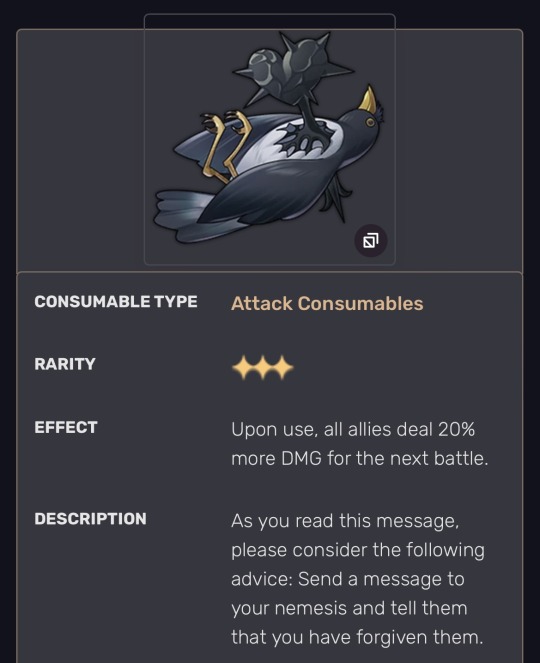

Hatred hardens the soul. Quite simply, hatred hurts. The bird has been speared through the chest with an amalgamation of tar-black weaponry, heart-shaped, a love hardened so cruelly and so slow it bubbled under the flesh until it simply became too much for the poor, dead bird.
The description asks “you” to consider sending a letter of forgiveness to your enemy. That, paired with the quote, leads there to be a strange self-awareness about the item. While the name is “Everlasting Hatred” and the art is macabre, leading me to believe it would fall into the same vein of straightforward emotion as the last two, the text on this one urges us to to the opposite of the item’s name. Instead of Everlasting Hatred, it tells us life is “too short to be wasted on feuds”.
I’m not sure if this means Sampo still carries this hatred and the text is a warning message, a cautionary tale of what may happen if he continues to hold onto it, or if Sampo has reached that enlightened point of realizing he needs to let go of his hatred. Whatever the case, the hate was there at some point, making it an important part of his story.
Betrayal and doubt catalyzed to create hatred, a resentment of his own purpose and creator, perhaps even himself. But hatred is as strong and deadly to oneself as it is to others, and it is important to be wary.
Overall, I see these items as taking us through a chronology of emotions, if nothing else — betrayal to doubt to hatred. Not only that, but betrayal as a singular moment, doubt as a haze present for quite some time, and hatred as a growing, bone-deep killer.
I tend to see this as an inciting incident, either Aha revoking Sampo’s Emanatorhood or some other cruel joke (or even creation itself as the joke), which then lead Sampo to question his own existence and purpose, which lead to doubt and eventual hatred once he realized his suffering was all some sick joke.
There are other interpretations I could make, of course, but this is the one I like the best!
Other Interpretations
— Throughout Penacony, especially considering Tatalov and how mysterious Sampo is on the whole (even on Belobog), it seems there is something not just that he won’t tell us, but potentially can’t. (Hence the distinction between “trying to say” and “reveal the truth” in Penacony.) Not being able to speak certain truths would certainly line up with a “secret that only Aha knows.” Perhaps part of Sampo’s existence is being unable to express his identity and purpose for fear of “ruining the joke” (Aha’s decision, not his).
— In many conversations, there only seems to be mean dialogue options to say to Sampo in-universe. It may be that the devs subconsciously find him annoying, or the game is supposed to be telling us the Trailblazer themself doesn’t like him, but I also think it could be a byproduct of his existence as a doll. Since Sampo’s purpose would be to be the recipient of emotional venting, it makes sense that others around him may be more… driven to extreme emotion in a subtle attempt by the laws of nature to, well, exercise his purpose. We may only have mean dialogue options people are supposed to become frustrated and angry and annoyed around him; being nice to Sampo too often may go against his entire reason for existence. If he was quite literally created to provoke these actions from others, it would make sense that people would act like this around him through no fault of his own.
— Under Doll Theory, I believe Curio Hacker may be Sampo’s way of trying to escape own existence or fate. Perhaps the “price” he is paying is to finally break free of his endless cycle of suffering and wealth. Additionally, the “hacker” part of Curio Hacker implies he is trying to bypass or find a loophole in something.
— Also, while I do believe Sampo’s outfit coloring may be to mirror Aha’s splash art coloring, it does not escape my attention that the red is on the outside, like blood. Red is also the color used by matadors to rile bulls up and… yeah… I’m sad now. :(
✩ ‧₊˚ ⌞ POTENTIAL TIMELINES & EVENTS ⌝
A quick and dirty of general events I feel could be chronological to Doll!Sampo’s story:
— Creation ➜ Abandonment ➜ Rebellion
— Betrayal ➜ Doubt ➜ Hatred
— Rise ➜ Pure Elation ➜ Suffering ➜ Spending
(Update: After looking at “Ace Trash Digger,” some of my thoughts below have changed. Mainly, I believe Sampo’s “betrayal” by Aha can be narrowed down to abandonment and being discarded on Jarilo-VI. I also think Sampo may not have become an Emanator until after he gained “advanced awareness” in Belobog, meaning he was just an Aha Stuffed Toy for a long time after his abandonment until he did something that prompted Aha to take interest in him. However, it is still possible he had been an Emanator Stuffed Toy previously, had that power revoked when he was discarded, only to gain it back once Aha took an interest again. Whether the abandonment happened because of a “joke gone too far” or Aha just genuinely believed Sampo to be “waste” is still up in the air. Okay, back to the pre-written stuff!)
(Additional Update: Due to the Ship of Fools Unknowable Domain occurrence, I also now believe that Sampo was likely abandoned due to being “unfunny” or otherwise “damaged goods,” and that Aha may, in fact, still view him as such. Alternatively, Aha may view all of Their dolls as unfunny, with Sampo being the singular part to catch Their eye due to his ability to survive and advance his existence on Belobog.)
Generally, I tend to believe Sampo was created either as an Emanator from the beginning, or as a doll — one among many — that Aha decided to rise to the status of Emanator. From there, he would experience the life of Jester of Anatta (or something similar), although he may have been able to convince himself it was worth something or that he was “special” due to his status and proximity to Aha.
However, despite giving and giving and giving through all the suffering, a betrayal would occur — likely something to do with Emanator status or another, similar kind of betrayal — that made him question everything. The doubt finally flared up and he realized how cruel his purpose, and by extension his creator, really was. Then, with that doubt morphing into hatred, he set out to find a way to break free, to get back at the one who betrayed him and subvert his own existence, paying a heavy “price” to do so.
Notes: Since the canon timeline of… well… anything having to do with Sampo is unknown as of now (2.6), there are several different amendments that could be made to this. For example, the “betrayal” may have been Aha revoking Sampo’s Emanator status as a joke, leaving him completely defenseless as a plaything for the Masked Fools or others, before reinstating his Emanator status once the joke got old.
In this way, Sampo could be an Emanator currently while still having the experience of losing Emanatorhood. Additionally, Sampo’s hatred may have turned to some kind of resigned enlightenment that is now present in canon, or it may still be there for all we know.
While there are many branching paths this timeline can take, I will stand by the general chronology of creation to suffering & betrayal to whatever plan he has going on now.
Additionally, throughout all of this, there’s a good chance that Doll!Sampo has either been earning money himself as an attempt at autonomy and self-control, or even perhaps a lingering compulsive cycle having to do with his currency-oriented origins.
✩ ‧₊˚ ⌞ THEORY OVERLAP ⌝
As stated in the introduction, Doll Theory can be used alongside several other theories.
— Emanator!Sampo: This is the main theory I see working with Doll Theory, as Aha is known to have a penchant for making literally whatever they find funny into an Emanator. With that poor worm in mind, I would almost be more surprised if Doll!Sampo wasn’t an Emanator at some point.
— Aha!Sampo: While my thoughts on the Aha!Sampo theory’s canonical likelihood have changed since starting this analysis, I still think it could work. Although Doll Theory does not see Sampo as a direct manifestation of Aha in Their entirety, he could still technically be “Aha” — or rather, perceived as Aha by others — due to similarities in appearance, voice, and mannerisms due to being created in Aha’s image.
— Mr. Cold Feet’s disillusionment and loss of confidence also work here, since those feelings of wanting to quit his job and being so exasperated with the Fools could stem from his unique perspective as a doll.
— Sampo wanting to protect Belobog makes sense as well, as he would likely see the Underworld as similar to himself — an underdog, a place where people suffer not because of their own actions but because of the misfortune of having others who exploit them. After the planet begins to emerge into the cosmos proper, Sampo now likely sees the whole planet as this vulnerable place in need of protection. He said it himself — he looks out for the little guy.
— Curio Hacker!Sampo is already something I interpret as evidence of Doll!Sampo, since Doll Theory gives him a direct reason to want to “hack” or find loopholes in the world around him.
I feel like many other theories could run alongside this as well, but these are the main ones that came to mind. Feel free to let me know if there’s any specific theories not mentioned here that you want to hear me talk about in proximity to Doll!Sampo!
✩ ‧₊˚ ⌞ THE VIOLENCE OF CREATION ⌝
Something that sticks out to me about Doll!Sampo is the theme of creation. Due to being based off the Aha Stuffed Toy occurrence, we know that he must have been created by Aha like the doll. However, that implies a certain… cruelty, intentional or otherwise. We know Aha to be casually cruel for the joke, like leaving the Noblesse Worm to suffer and die after They got bored of Their little experiment, so it wouldn’t be surprising to me that They would make yet another ill-executed joke.
Sampo’s creation specifically, though, speaks of an almost violent intention to me. Aha is an Aeon, it’s not like They’re unaware of the suffering of mortals. If anything, They’re likely to delight in it. So, They intentionally created a doll, a sentient being capable of feeling pain, to be used for the express purpose of suffering. They wanted to see Themself beaten up, and instead of taking the brunt of it Themself, in Their own form and consciousness, They created another being to go through it for them. A doll with the face of its creator, meant to be tormented. That’s violent to me. That’s cruel.
I don’t have much else to say, other than I wanted to point it out. Creation, especially of godly origins, is often seen as divine and pure in nature, even within the HSR universe. However, I do not believe there is anything well-intentioned about Aha’s creation of Sampo. In my eyes, it’s just divine cruelty.
✩ ‧₊˚ ⌞ THE UNCANNY DIVINE ⌝
Speaking of divinity, I do love the idea of Sampo being both so uncanny and so… godly. If he really is an Emanator, or even just made in the image of Aha, that puts him in proximity to what many in-universe see as a religious figure.
In popular culture in our own universe, religious figures are often seen as comforting, pure, and remarkably virtuous. What I love about Sampo is he’s just so uncanny. He doesn’t leave footsteps when he walks, he’s incredibly cryptic, he’s a con-man for a living. He’s so mysterious in a way that fits more into the uncanny valley than it does into any divine book or religious text, and I love it. He is out here living his life as a god, quite literally just fucking around and finding out.
✩ ‧₊˚ ⌞ THE TRAGEDY OF A DOLL'S EXISTENCE ⌝
Tragedy. Cruelty. Suffering. These are all words I associate with Doll Theory. It is by far one of the darker ones out there, at least in concept. Sampo has no control over his means of creation, no autonomy to decide his purpose or his next steps. They are all determined for him by the god he is a son to, the ever-watchful eyes of a crowd holding their breath and baring their teeth for a good show. He has no choice. This is what life is.
He is Organic Heart. He is the combination of two twisting things never meant to be joined, a still-beating sentience trapped within the rotting shell of a fruit. Mysterious Magnetism clings to him like a ghost, a wanting, warping thing that fractures the senses. At his birth, his fate was sealed. A heart can never be more than a heart, an apple never more than an apple. Since the beginning, he was made to be devoured.
He is the Jester of Anatta. He rises, he falls, he entertains just to fall apart. The audience claps. It was easy, at first, to convince himself this was privilege. He was privileged, special, important. He was born in proximity to the luminosity of an Aeon, not just in voice or in appearance but in soul. The vibrating shadows of the audience did not know this privilege — he should be grateful. But time wore on, as always. Soon, a seed of doubt was planted, buried among soft fields of self-pity. Was this all life was? Was this all he was meant for? … Was this really a privilege? He breaks for the thousandth time, and wonders.
He is Betrayal. Doubt. Hatred. The one sliver of power he had clung to, had convinced himself was worth it, is gone, nothing more than a cruel joke twisting in the wind. It does not matter what happens next. All that matters is now. By the end, he is spent, all hollow cracks and the fading whisper of a laugh. What was once full is empty. Like a small ceramic bank, he collects his pieces off the floor. He uses spare coins to wedge himself together, but tar seeps through the gaps.
He is Curio Hacker. Electronic, buzzing, only existing in mirrors. He’s picked up a sort of gambling addiction, and now he’s virtually virtual. Pay the price, take the wins, cut the losses. That’s how life goes. He makes himself an offer he can’t refuse. “You sly dog,” he says, eye-to-eye with a seeping black gash in the mirror. “You drive a hard bargain.” He accepts, eventually, and begins down a long road. No fault but his own, but the price is worth paying. A clipped bird in a winged cage, isn’t that ironic? He leaves with more than a few deals in tow.
He is Hazardous Waste. He’s made his home in a far-off place, finding some strange warmth in the biting cold. Still, he can’t shake the feeling of lingering dread, of the tar inside hardening, cracking, bubbling into poison. He may be discarded, but his bleached fangs hold a venom of their own. He thinks about how far he’s come. He wonders if anyone remembers him. For a moment, he hopes he’s reached for again, plucked from obscurity for a last show, just so he can bite the hand that feeds. A predator is still prey to something, but he doesn’t care. He’s become more than a thing, more than a limp-limbed marionette. He has teeth, now. He will use them if he has to.
He is a doll. A stuffed toy. A freshly-painted mound of clay shaped into form and rolled under the bed, out of sight, until he collects dust in the darkness. No amount of running can change that. No amount of growing can stop it. Despite his efforts, the constraints of his own existence wear thin. Tape over his mouth, laughter in his ears, a headache building where his head has cracked against the ground. The only thing that’s changed is the money in his pocket. He clings to it like a lifeline, like a perfect goddamn savior, as if a small bit of green can wash away centuries of spilling gold. As much as he tries to hide it, he is scared. The paper reminds him of brightly-colored confetti.
He is a hacker, he is a toy, he is a model of a god. He is more than the sum of his parts; he is confined to everything that he is. A heart-apple, an apple-heart, and a generous amount of venom-tar in between. He is hatred, doubt, betrayal. He is a protector, but never protected. He is a vessel forged from divine cruelty, born anew from the warmth of snow. He is all of these things. He has to be. And isn’t that just a tragedy?
☆━━━━━ ⋆⁺。˚⋆˙‧₊☾ ◯ ☽₊‧˙⋆˚。⁺⋆ ━━━━━━☆
.𖥔 ݁ ˖ જ⁀➴ thank you for reading my magnum opus! this theory is very dear to my heart and has been driving me insane for at least four months !! :)

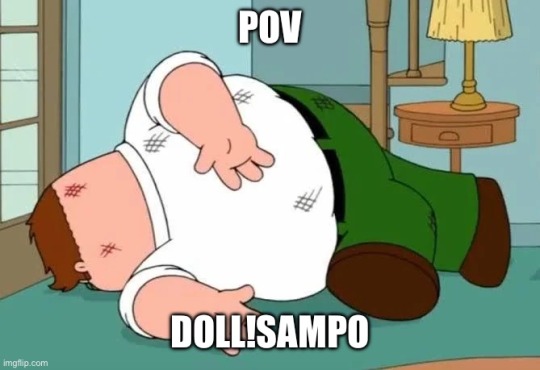

☆━━━━━ ⋆⁺。˚⋆˙‧₊☾ ◯ ☽₊‧˙⋆˚。⁺⋆ ━━━━━━☆
© analysis by sunderingstars. do not copy, repost, translate, modify, or claim my work as your own.
#⌞ ✎ sunder.writes ⌝#⌞ 🎭 ⌝#happy halloween !! 🎃#nothing’s scarier than the existential dread of a creation abandoned by its creator#hsr#honkai star rail#honkai: star rail#sampo#sampo koski#sampo hsr#hsr sampo#sampo honkai star rail#analysis#hsr analysis#hsr theory
55 notes
·
View notes
Text
⛧𓋹⛧𓋹⛧⛧𓋹⛧𓋹⛧⛧𓋹⛧𓋹⛧⛧𓋹⛧𓋹⛧⛧𓋹⛧𓋹⛧⛧𓋹
𝑇𝐻𝐸
𝑆𝐻𝐴𝑃𝐸𝑆𝐻𝐼𝐹𝑇𝐸𝑅
ᚠ ᚢ ᚦ ᚱ ᚲ ᚷ ᚹ ᚺ ᚾ ᛁ ᛃ ᛇ ᛈ ᛉ ᛋ ᛗ ᛏ ᛜ ᛚ
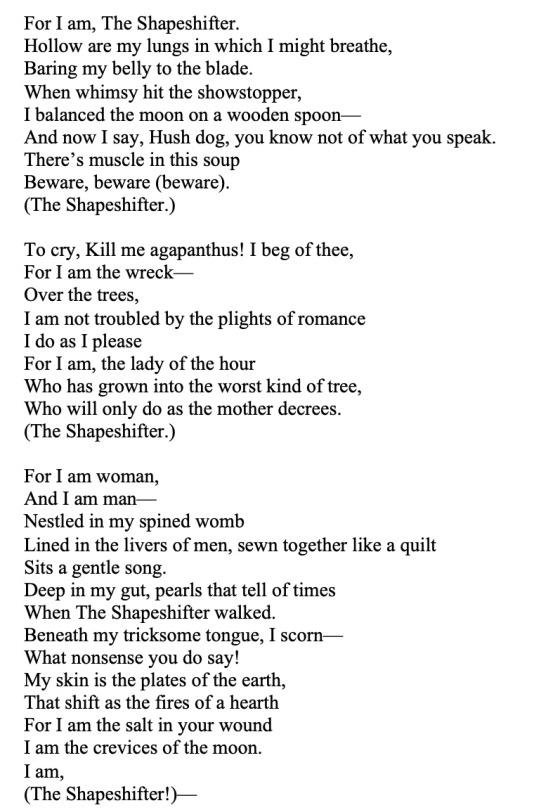
I greet thee dear, welcome to my blog. I am The Shapeshifter, The Wizard Goose, Plague upon John of England *menacing honking*. I am a Witch and a feral beast. I spend these days in which I suspend casting runes, spitting tricksome prophecies and harassing the English monarchy. How I have come here I know not, but joyous I am to converse with thee. I hope thou may find a thing of sorts here, whether it be comfort, whimsy, disturbance or perhaps the cup of dice.
𓋹
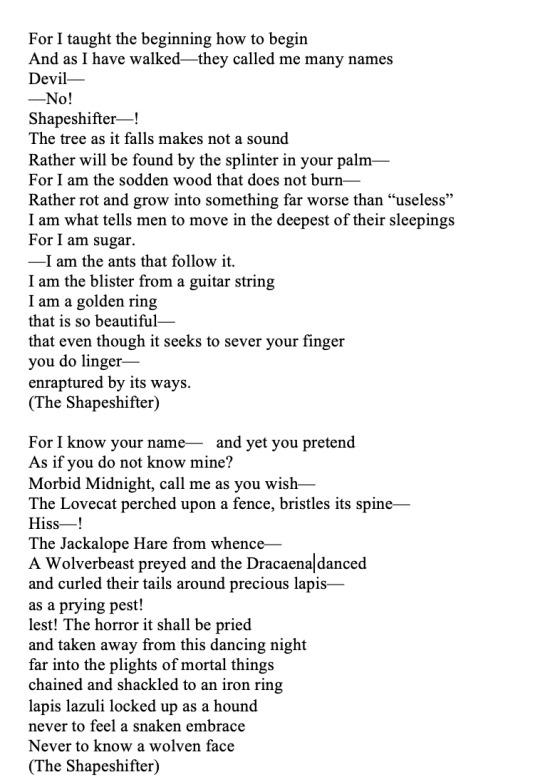
𓋹
I am called many names. Shapeshifter. Versipellis, Gestaltwandler, ilcruthach, Vormveranderaar. All words meaning Shapeshifter. As well as Werewolverine, Lovecat, Dracaena, She-wolf and Jackalope Hare. These names I did snatch into my claws while doing historical, mythological, folkloric and etymological research. If you wish to know the etymology and history of these names look upon this post
🕸️What art thou to call me? however you please. Choose one in the previous list or assign me thine own title. As long as it is done with respect I shalt answer. To be given a name is a great honour. 🕸️
⛧𓋹⛧𓋹⛧⛧𓋹⛧𓋹⛧⛧𓋹⛧𓋹⛧⛧𓋹⛧𓋹⛧⛧𓋹⛧𓋹⛧⛧𓋹
I fall under the definition of nonhuman, I take many forms. Most notably a goose. Much of the posting thou may see upon here is I, The Mighty Goose, Plague upon John of England violently honking or screeching in Shakespearean. I often find myself taking forms such as that of a siren, Dracaena, Wolverine, Harpy, Jaguar, Bin Chicken, Hyena and jackrabbit. The forms in which I might take are boundless as the ways of water across this sphere. For I am whatever I please.
ᛐᛜᚢᚦ
☾ I bear connection to mythological and folkloric shapeshifters, as to be they are ballads of myself or perhaps a close friend ☽
My gender is fluid. The pronouns I do favour art he/she/it, preferably alternating between the three as I cannot be confined by one singular. I am polyamorous and queer. OOooOooOh hOnK hOnK
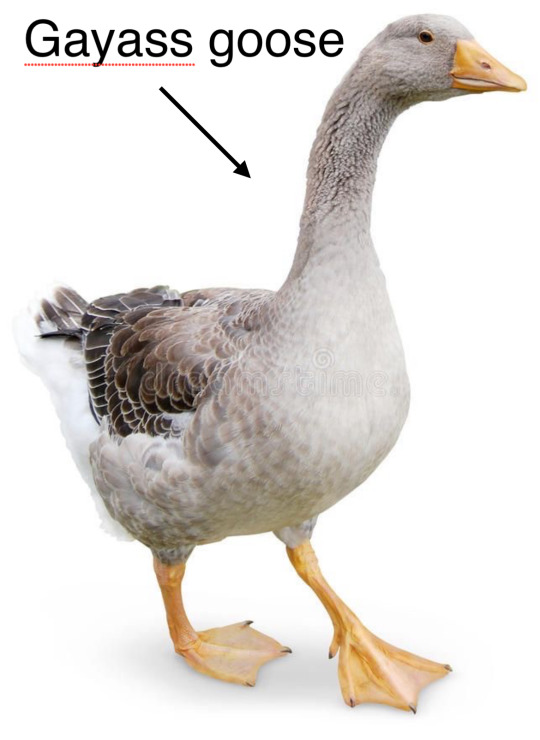
As of now I am writing The Shapeshifter. A ballad describing my identity. Here you may find what of it has been released. For the past four years I have been crafting a novel series. It is influenced by folklore and mythology, containing queer, nonhuman and disabled characters.
𝑃𝑂𝐸𝑇𝑅𝑌 𝑆𝐴𝑀𝑃𝐿𝐸𝑆
The Shapeshifter's lament (part of the Shapeshifter)
The Shapeshifter
Vivamus Moriendium Est
Fight Dog
The Verdict
𝑀𝑌 𝑁𝑂𝑉𝐸𝐿
Lore
Character intro

I am disabled and neurodiverse. I have FND, tourettes and POTs and I am a cane user (in need of a wheelchair but unable to access). I have OCD, ADHD, sensory processing and likely autism. I will often post about disability advocacy on this blog. I am apart of the goth subculture (my favourite bands art The Cure, Inkubus Sukkubus, Sisters of mercy, Bauhaus, Scary Bitches, Coctaeu twins). I am interested in classical literature, History, Folklore, Paganism, vulture culture, Etymology, Shakespeare and gothic horror. I will on occasion post images of my goth makeup upon this platform. I art a minor, be freaky and thou shalt be CURSED I say! grime of a chicken hearted mutt upon thee for thou art liver bellied and foul as a cattle foot in a yew stump.
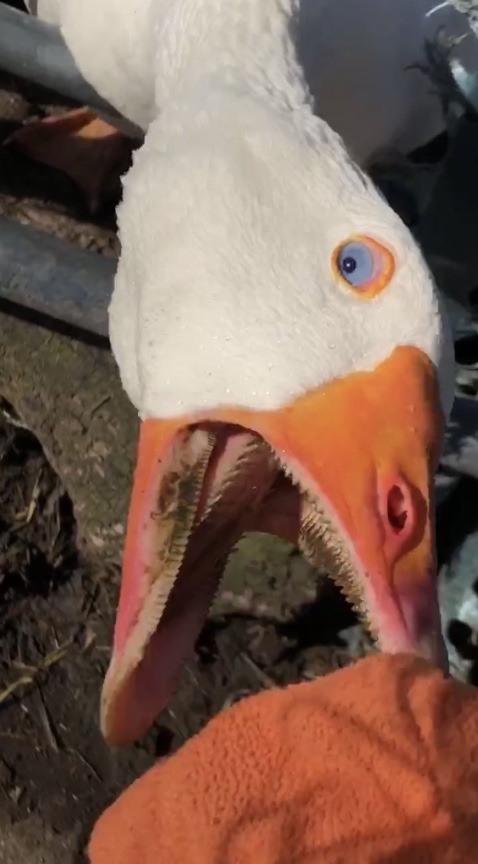
ReQUESTS (honk)
The Challenge of the goose, tis a challenge where I the tricksome goose shalt grant thee a riddle. Simply request for one in mine ask box or say "I call upon the challenge of the goose". I will trial thee with a riddle I have written, if thou does succeed I shalt grant thee an honorary goose title.
In addition if thou art curious about my writing, identity as a shapeshifter or wish to ask me any questions, do so. Tis no reason for shame, inquiry and curiosity about what we do not understand is a wonderful thing.
Goth resources
Boundaries:
I AM A MINOR!!!! I will not private message with adults, adults can interact with my blog but private messaging is off the table. DNI: perverts and bigots. I don’t mind images of dead animals as long as it isn’t a dead goose. Please don’t send me pictures of dead, injured or cooked geese.
Tags:
#the shapeshifter's riddles : my poems
#morbid lore : to do with my ongoing ye olde goose feud with the entirety of Britland.
#challenge of the goose: answering riddle requests
#morbid memes: memes I have made myself (as seen below, mostly to do with geese)
#morbid's gaggle : interactions with moots
#morbid midnight : I tend to tag all my posts under this tag.
#morbid Reblogs
And now I must return to unionising the cows under lesbianism against John of England. Upon thee I wish plentiful fruit, soft sun upon thine cheek, much bounty and many adventures to seek. May the skin of your palms be coarse to the Strike of a bramble. So says The Shapeshifter
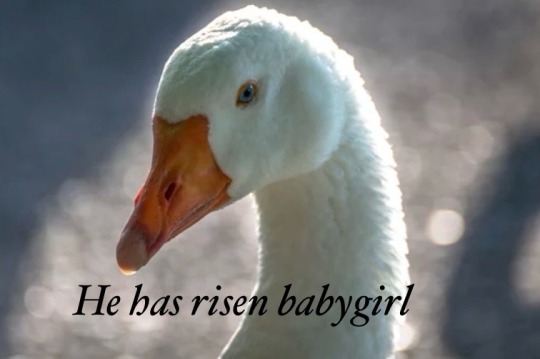


#the shapeshifter's riddles#morbid's memes#morbid lore#morbid's gaggle#morbid midnight#the challenge of the goose#honk#goose#silly goose#etymology#history#neurodivergent#nonhuman#otherkin#tics and tourettes#disabled#intro post#get to know the blogger#shapeshifterkin#get to know me#queer#poets#writers#writers on tumblr#novel writing#writer stuff#queer writer#queer poetry#therian poetry#writeblr
50 notes
·
View notes